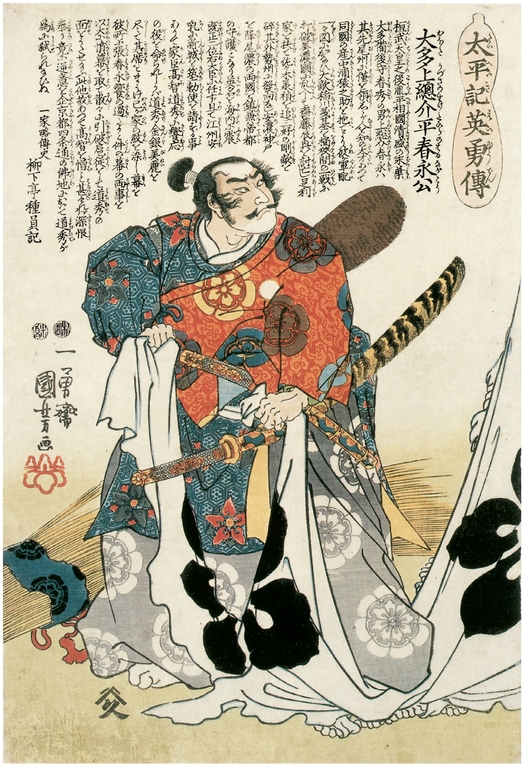
1. Oda Nobunaga. Samurai Oda Nobunaga in a moment of focused rage, tearing down a tent curtain decorated with the crest of his treacherous vassal Akechi Mitsuhide. He wears the samurai’s traditional dual swords, one longer and one shorter, and carries a quiver of arrows on his back. The tiger fur covering his long scabbard confirms Nobunaga’s high status as a warlord.
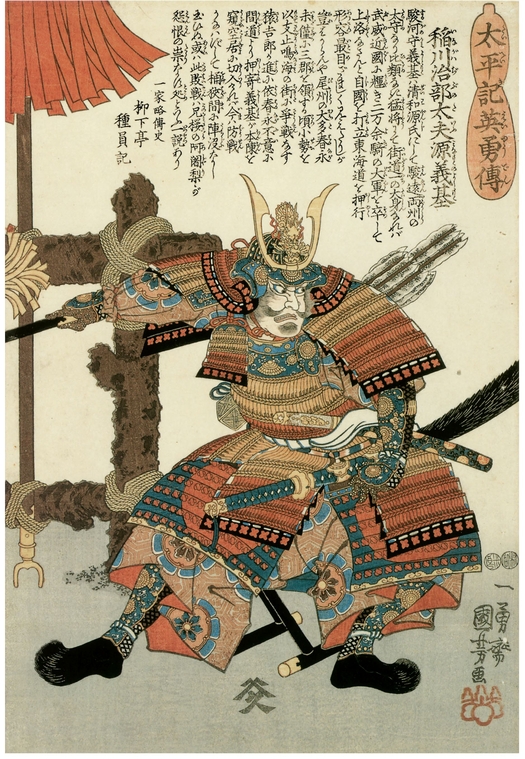
2. Imagawa Yoshimoto. Yoshimoto is shown holding a samurai commander’s saihai, a baton, in his right hand, and wearing a helmet decorated with fierce-looking horns. Standing in front of a wooden stockade, confirming that this is a battlefield scene, Yoshimoto’s posture and expression convey the anxiety which even the fiercest samurai could feel in the face of an approaching enemy. Yoshimoto was indeed killed in battle. On the left, tied to the stockade, is the samurai’s yaguraotoshi, a long-handled weapon used in attacking castles that ends in a crescent-shaped metal point.
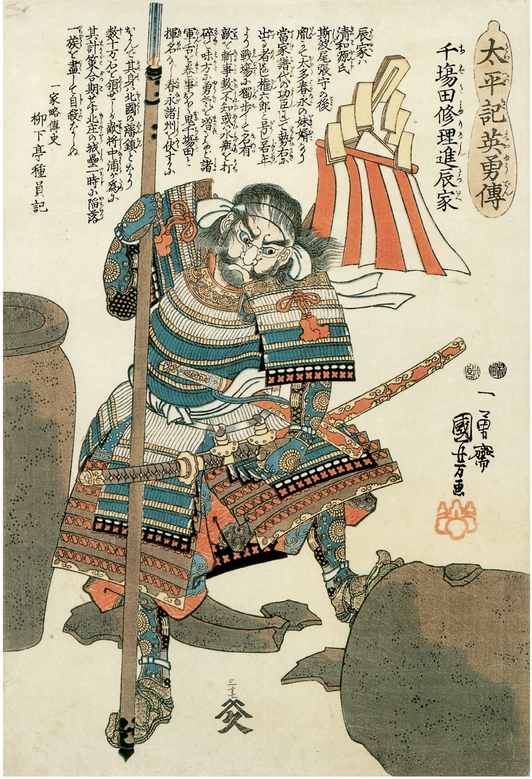
3. Shibata Shurinosuke Katsuie. Shibata is depicted destroying his own troops’ water vessel, an act he indeed carried out to focus his warriors’ spirits in a successful battle. Above the samurai’s left shoulder is his personal standard, decorated with paper streamers.
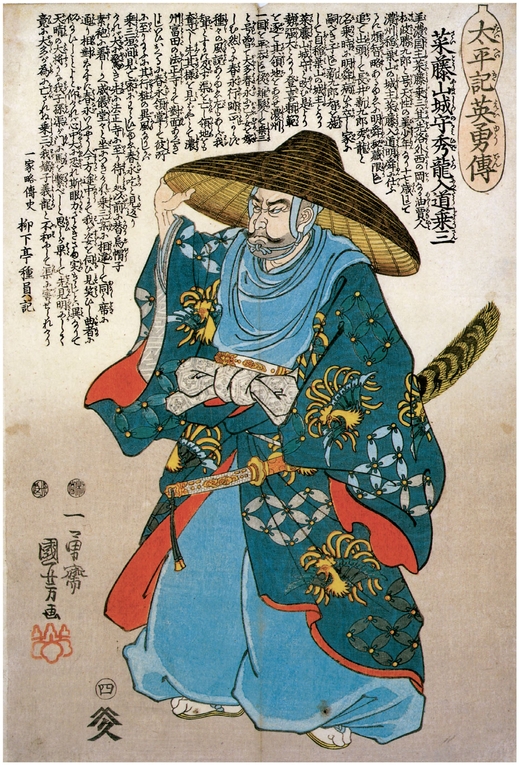
4. Sait Toshimasa ny
Toshimasa ny d
d D
D san. The samurai is wearing a large hat to facilitate spying on Oda Nobunaga in a situation away from the battlefield—Sait
san. The samurai is wearing a large hat to facilitate spying on Oda Nobunaga in a situation away from the battlefield—Sait was trying to determine for himself if Nobunaga would make an acceptable son-in-law. The richness of his cloak’s decoration, as well as the tiger fur scabbard, confirm Sait
was trying to determine for himself if Nobunaga would make an acceptable son-in-law. The richness of his cloak’s decoration, as well as the tiger fur scabbard, confirm Sait ’s status as a powerful warlord.
’s status as a powerful warlord.
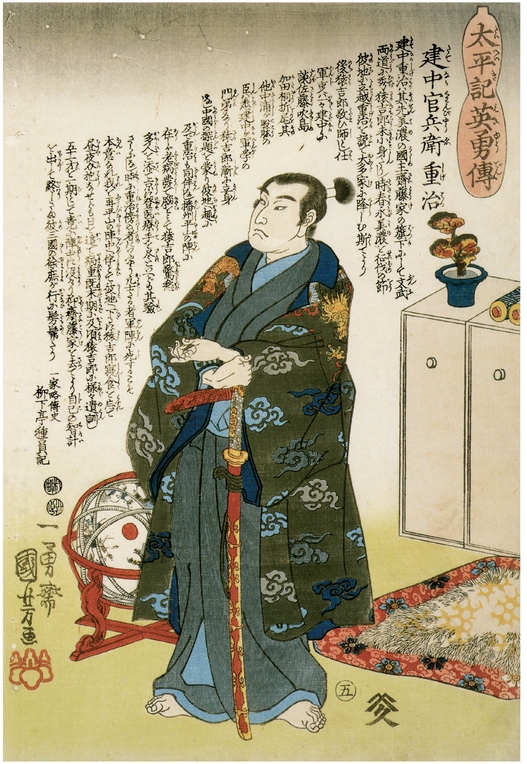
5. Takenaka Hanbee Shigeharu. Takenaka is surrounded by the attributes of a highly intellectual advisor to a military commander, including the scrolls on the sideboard and the celestial globe in the armillary sphere. Study of the disposition of heavenly bodies played a major role in the planning of the samurais’ military actions, confirmed here by the stars in the night sky above the interior scene.
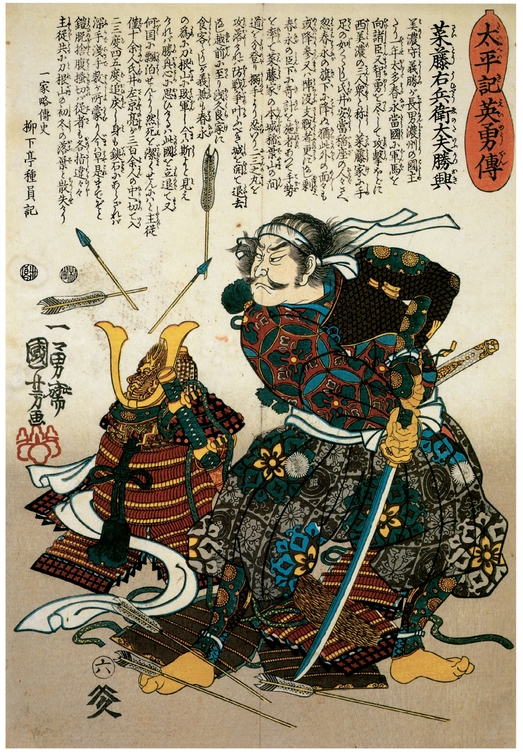
6. Sait Uheenotay
Uheenotay Tatsuoki. The samurai seems to be successfully warding off enemy arrows with his sword, but the helmet and armor on the ground beside him indicate that the warrior knew the end was near. In a hopeless situation with his troops outmanned, Sait
Tatsuoki. The samurai seems to be successfully warding off enemy arrows with his sword, but the helmet and armor on the ground beside him indicate that the warrior knew the end was near. In a hopeless situation with his troops outmanned, Sait Tatsuoki removed his armor and committed suicide.
Tatsuoki removed his armor and committed suicide.
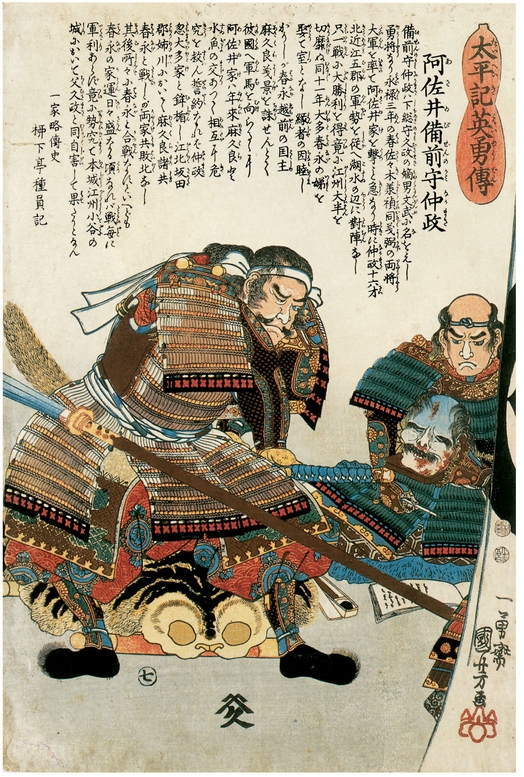
7. Asai Nagamasa. Sitting on a campstool covered with a tiger pelt, Asai turns toward the source of the spear being thrust in his direction from the lower right. Another samurai sits behind him holding the severed head of a defeated enemy, no doubt for presentation to his commander. Holding a writing implement in his right hand, with paper on the ground before him, this warrior may either be preparing to compose a record of the battle just ended, or writing a farewell poem, an act often preceding a samurai’s suicide as might be required by what happened on the battlefield that day.
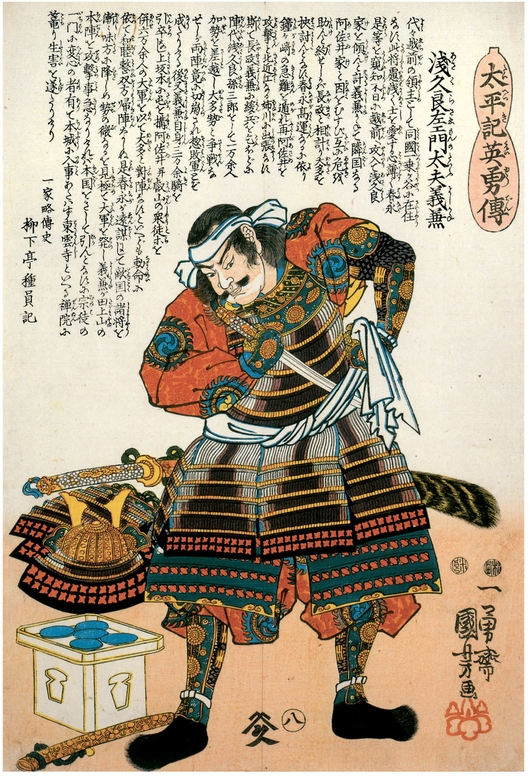
8. Asakura Saemonnokami Yoshikage. Continuing a theme which runs through many of Keniyoshi’s samurai prints, Asakura Yoshikage prepares to commit suicide after finding himself in a hopeless battlefield situation, betrayed by his vassals and his household. After placing his helmet and armor on the ground, the samurai is cutting away his garments. At the lower left is a portable table with cups for sake, perhaps to be used at a ceremonial farewell feast prior to the final act of suicide.
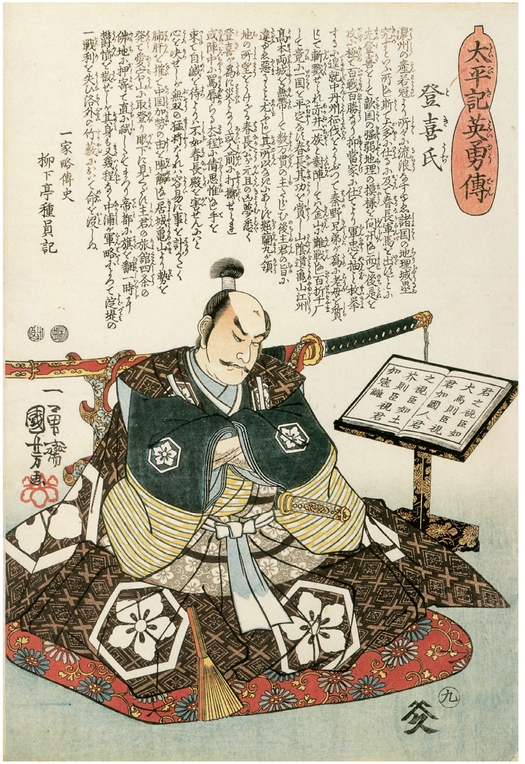
9. Akechi Mitsuhide. The samurai in repose with the elegant accoutrements of a warrior. The book on the lectern is open to a text by the Chinese philosopher Mencius concerning the consequences of a ruler’s disregard of his subjects, no doubt a reference to the cause of Akechi’s revolt against Oda Nobunaga, one of the key events of this period. Akechi’s katana, his longer sword, is on the elegant rack behind the seated samurai.
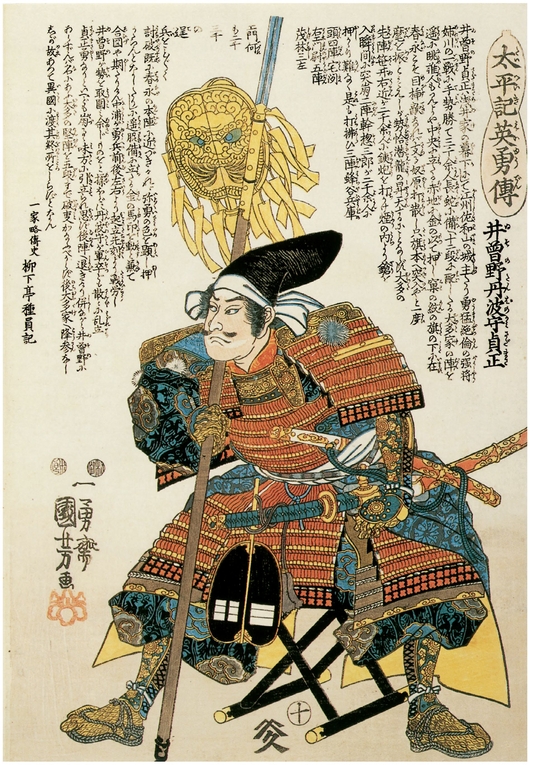
10. Isono Tanba-no kami Kazumasa. The samurai is sitting on his campstool in front of his sashimono, his personal standard in the shape of a lion’s head with golden strips representing the mane. The commander’s fan hanging from his long sword is decorated with cosmological signs from the I Ching, reflecting the philosophical knowledge expected of an intellectual military thinker.
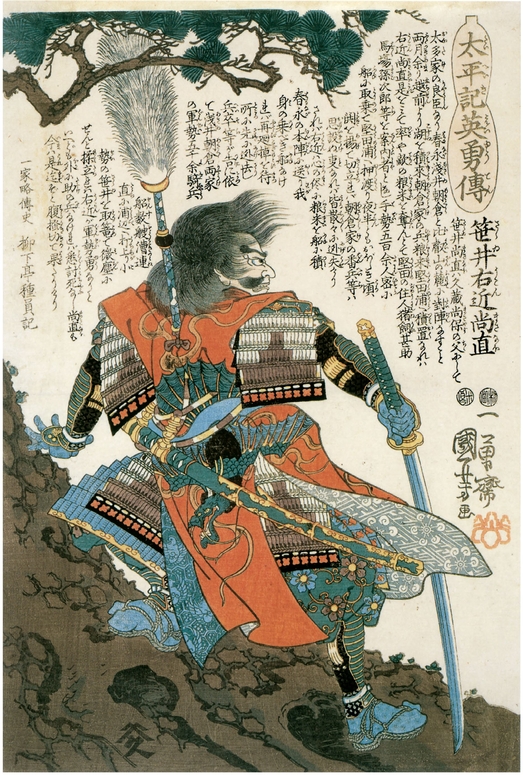
11. Sakai Ukon Masanao. The samurai depicted is in a heroic and ferocious pose, his sword out of the scabbard and ready as he turns to face the enemy which pursues him. The dragon on his cloak is a symbol of invincible power. Following a brutal defeat, however, Sakai Masanao committed suicide on the battlefield.
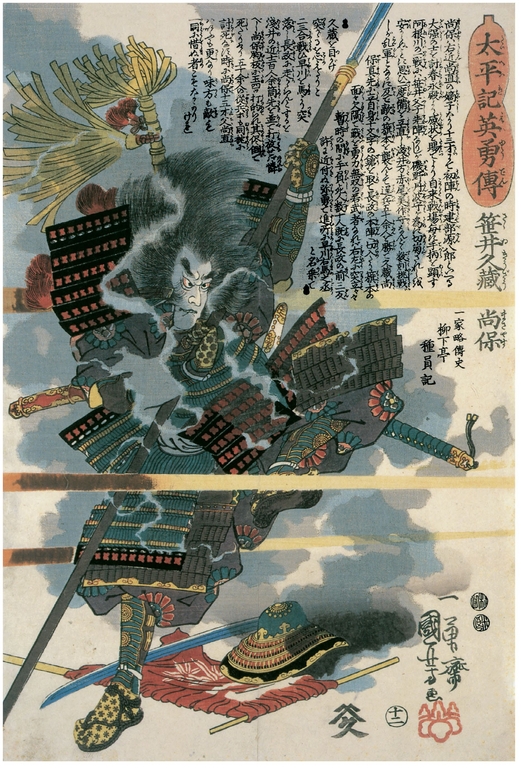
12. Sakai Ky z
z Narishige. The samurai’s expression and posture reflect his indomitable fighting spirit, but the helmet, standard, and sword lying on the ground in front of him indicate that this battle has been lost.
Narishige. The samurai’s expression and posture reflect his indomitable fighting spirit, but the helmet, standard, and sword lying on the ground in front of him indicate that this battle has been lost.
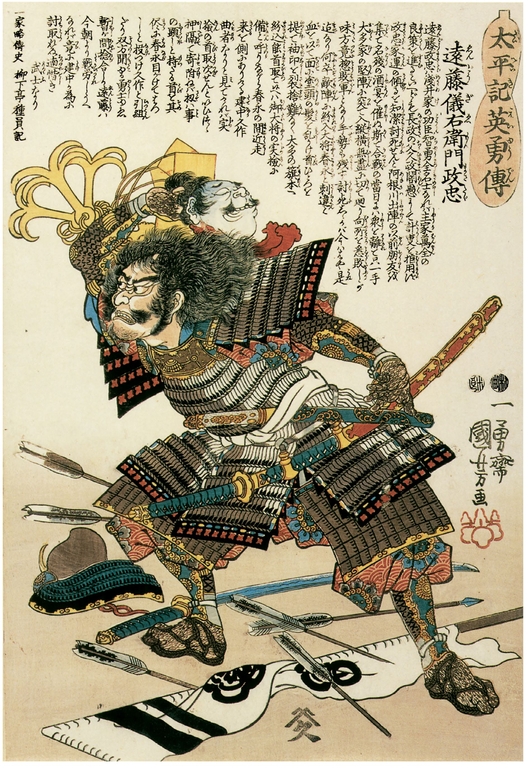
13. End Kiemon Naotsugu. Warding off a heavy arrow barrage, End
Kiemon Naotsugu. Warding off a heavy arrow barrage, End is preparing to return fire with the severed head of an enemy warrior. The multi-hooked weapon above his right elbow is a kumade, or bear’s clutch.
is preparing to return fire with the severed head of an enemy warrior. The multi-hooked weapon above his right elbow is a kumade, or bear’s clutch.
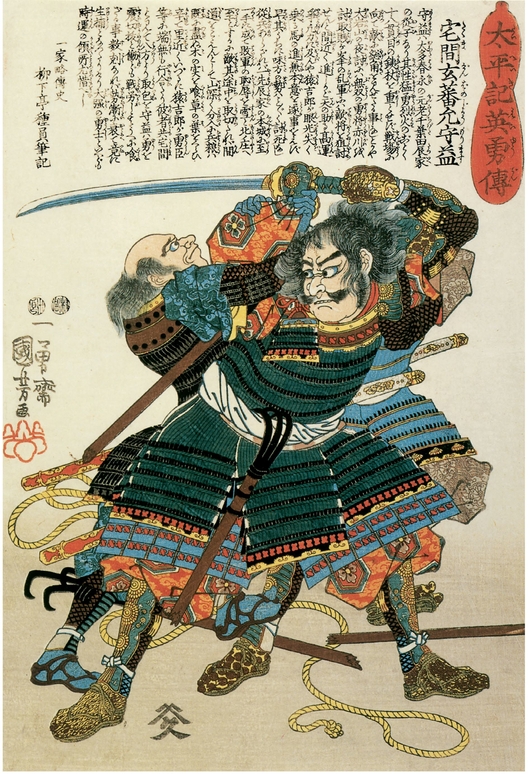
14. Sakuma Genba Morimasa. In this lively print Kuniyoshi depicted Sakuma being arrested by the henchmen of his enemy Hideyoshi. At first glance it appears that only one opponent is attacking Sakuma, but there are six feet visible in the picture, indicating that at least two men were needed to take on the powerful samurai.
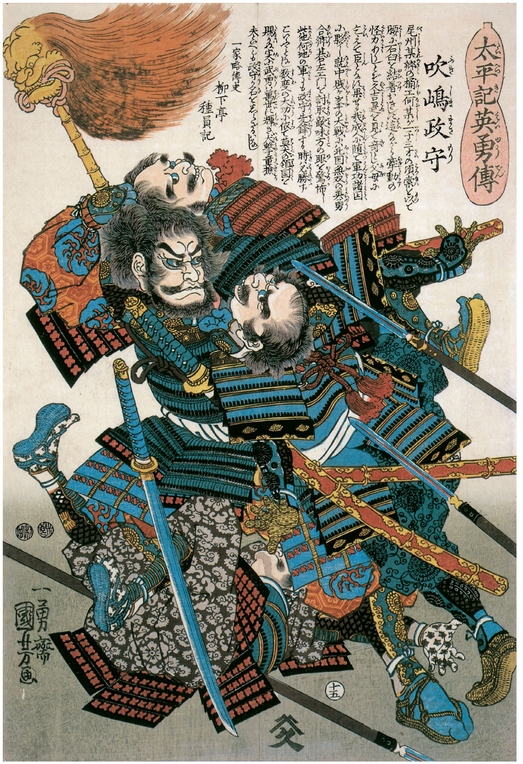
15. Fukushima Masanori. Masanori is in close combat with three opponents simultaneously. The samurai’s fierce expression is mirrored by the mask at the top of his personal standard.
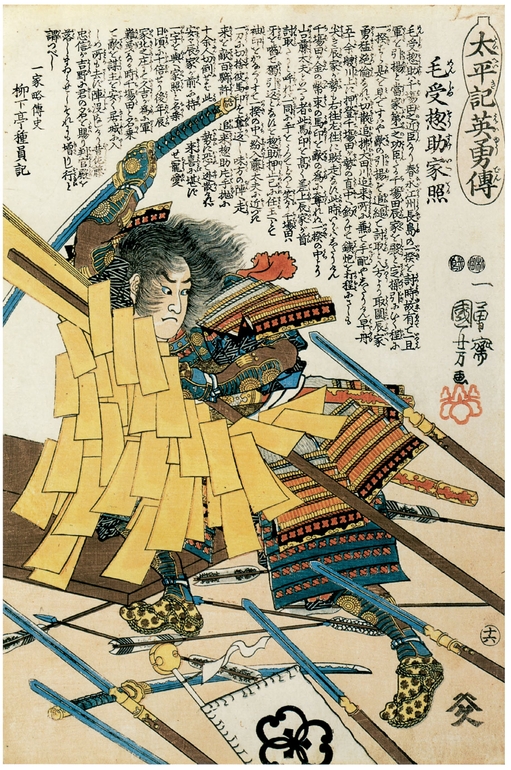
16. Menju Sh suke Ieteru. Under a fierce spear attack by unseen opponents, the young samurai Menju Ieteru has successfully retrieved the signpost of his lord, decorated with many strips of gold paper, from the hands of their enemies.
suke Ieteru. Under a fierce spear attack by unseen opponents, the young samurai Menju Ieteru has successfully retrieved the signpost of his lord, decorated with many strips of gold paper, from the hands of their enemies.
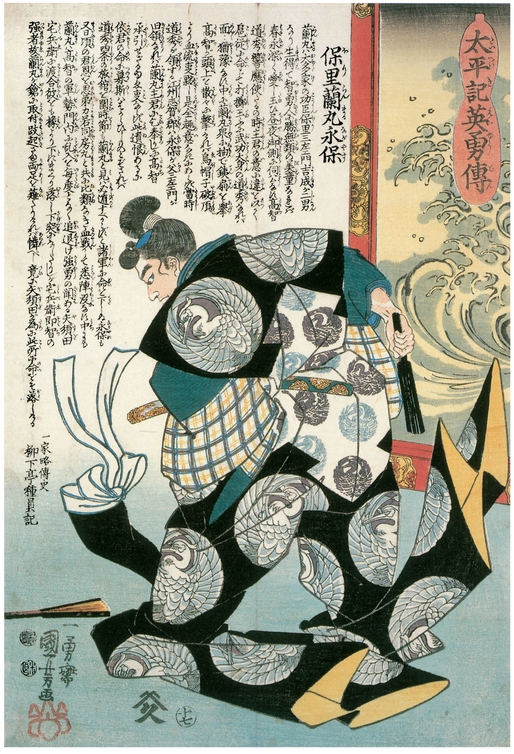
17. Mori Ranmaru Nagasada. The fusuna, a decorated sliding screen, seen at right, confirms that the samurai Mori Ranmaru is engaged here with an opponent inside a castle. The elegantly dressed samurai has just, at his lord’s command, struck his unseen opponent with the metal fan he holds in his right hand. The victim of this attack, Akechi Mitsuhide, has lost his hat which is seen floating, decorated with ribbons, on the left, and dropped his own fan at Ranmaru’s feet.
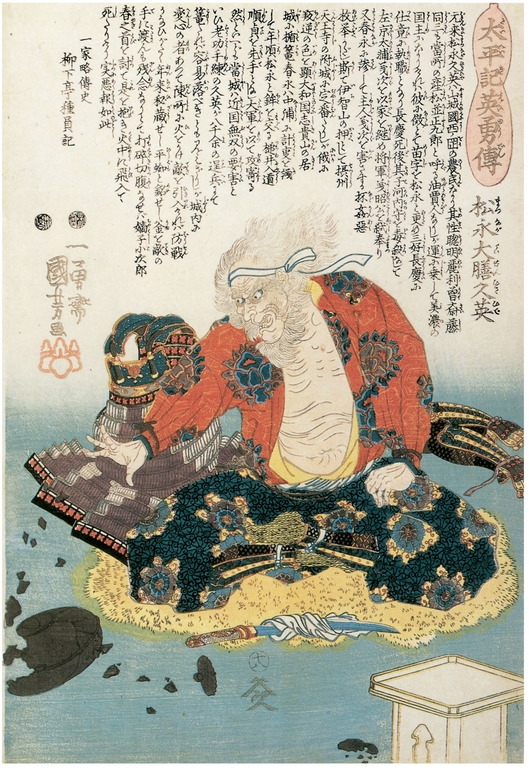
18. Matsunaga Danj Hisahide. Samurai Matsunaga Hisahide about to commit seppuku when facing defeat by an insurmountable opposing force. The 67-year-old warrior, seated in the appropriate position, has removed his armor and shattered a cherished tea ceremony vessel to keep it from falling into his enemy’s hands. The knife with which he will kill himself is on the ground in front of him, its blade wrapped with a cloth to prevent it from penetrating farther into his abdomen than called for by the requirements of the ritual. Generally, as soon as the samurai had plunged the knife into his abdomen, he would be decapitated by a comrade.
Hisahide. Samurai Matsunaga Hisahide about to commit seppuku when facing defeat by an insurmountable opposing force. The 67-year-old warrior, seated in the appropriate position, has removed his armor and shattered a cherished tea ceremony vessel to keep it from falling into his enemy’s hands. The knife with which he will kill himself is on the ground in front of him, its blade wrapped with a cloth to prevent it from penetrating farther into his abdomen than called for by the requirements of the ritual. Generally, as soon as the samurai had plunged the knife into his abdomen, he would be decapitated by a comrade.
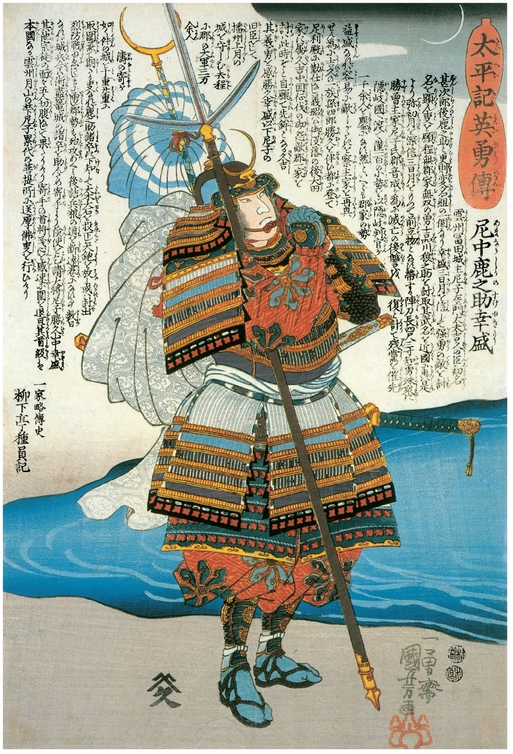
19. Yamanaka Shikanosuke Yukimori. The samurai in full regalia stands by a body of water, hands clasped in a prayerful position, gazing at the crescent moon, its shape recapitulated in the decorations on his helmet and at the top of his standard. The blue and white cloth object attached to the back of his armor is a horo, designed for protection against arrows.
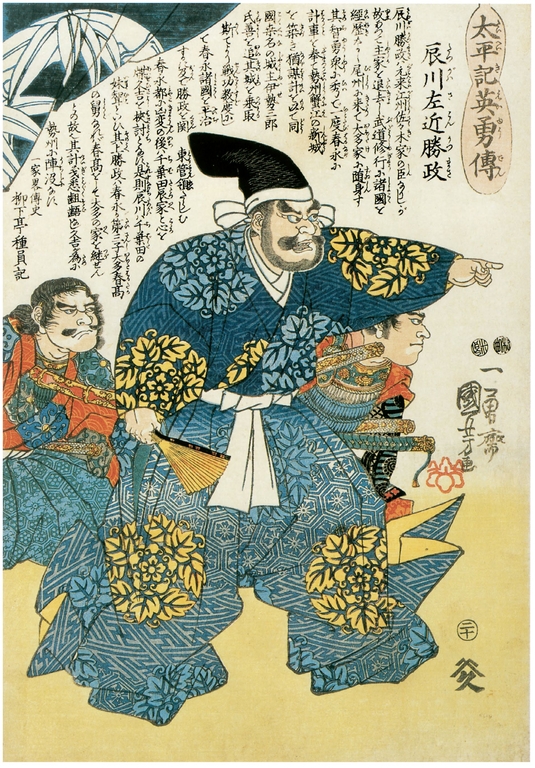
20. Takigawa Sakon Kazumasu. Not wearing the samurai’s armor in this print, but still holding his commander’s fan in his right hand, the powerful Kazumasu forcefully directs his subordinates with his left.
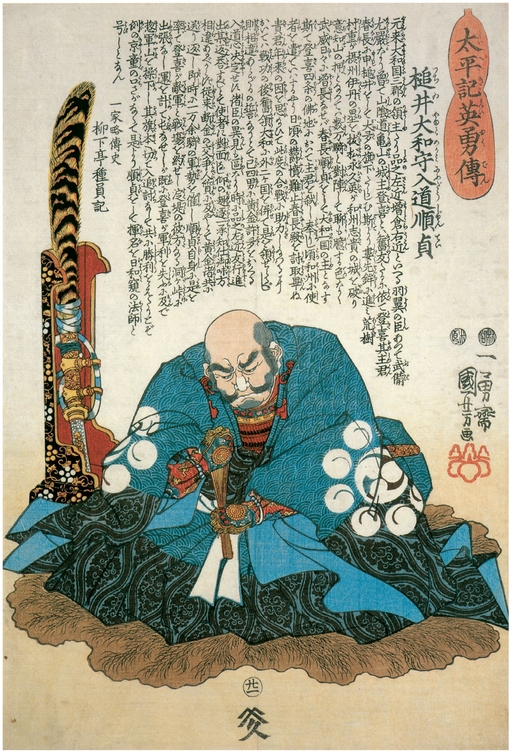
21. Tsutsui Junkei. Holding his commander’s fan tightly with both hands, Tsutsui appears deep in contemplation of a fateful decision. His longer sword is stored in a tiger fur sheath by his side. Tsutsui’s shaved head confirms that in addition to being a warrior, he is also a Buddhist lay monk.
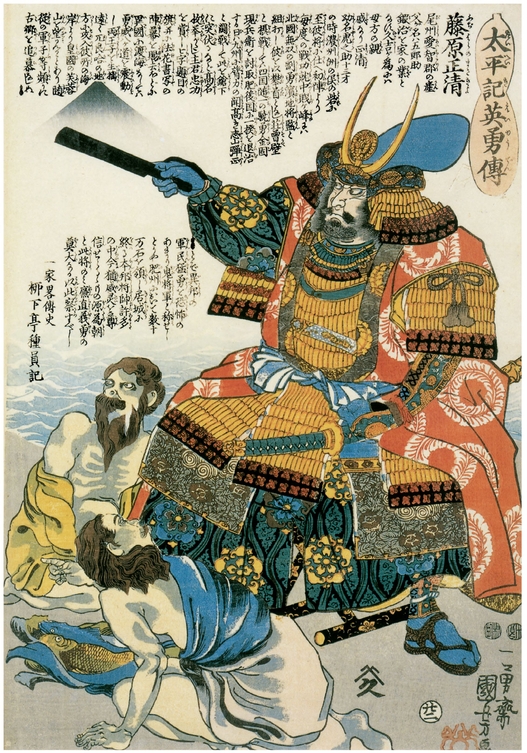
22. Kat Kiyomasa. The samurai in a commanding pose during a campaign in Korea in 1592. Two native fishermen, dressed only in rags, are at his feet.
Kiyomasa. The samurai in a commanding pose during a campaign in Korea in 1592. Two native fishermen, dressed only in rags, are at his feet.
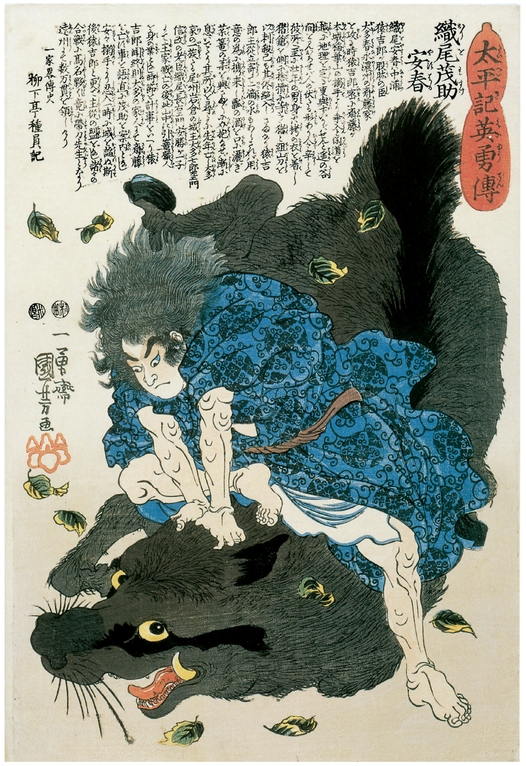
23. Horio Mosuke Yoshiharu. Horio Yoshiharu was a young warrior who retreated into the woods and lived as a hunter following the downfall of his first lord’s house. Here, with no weapons, he is in hand-to-hand combat with a gigantic wild boar. After this incident he formed a connection with a new lord and made a dramatic comeback as a samurai, successful in many battles.
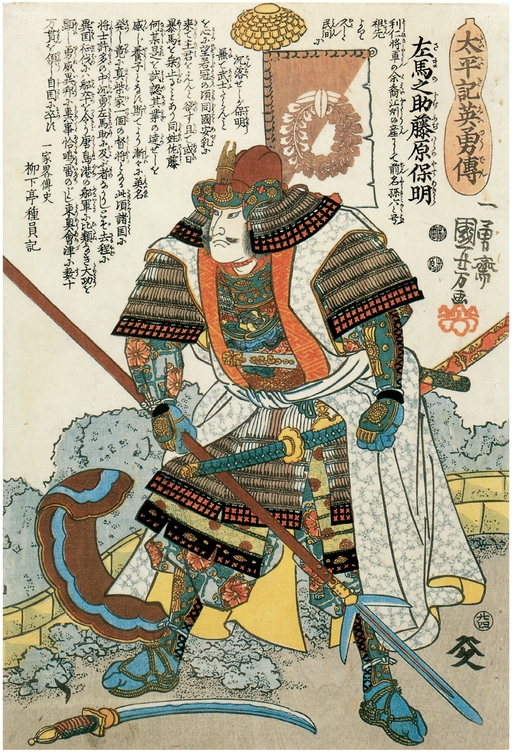
24. Kat Samanosuke Yoshiaki. The determined samurai, in full battle armor ready for action, stands on a walled fortification, spear in hand.
Samanosuke Yoshiaki. The determined samurai, in full battle armor ready for action, stands on a walled fortification, spear in hand.
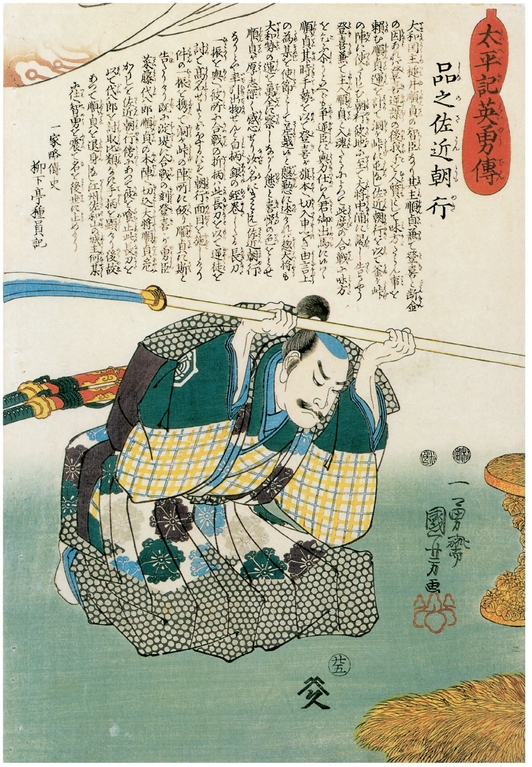
25. Shima Sakon Kiyooki. The samurai in a humble position, receiving a gift from his master. He holds his naginata, or long spear, in a respectful attitude to the unseen lord, Hideyoshi.
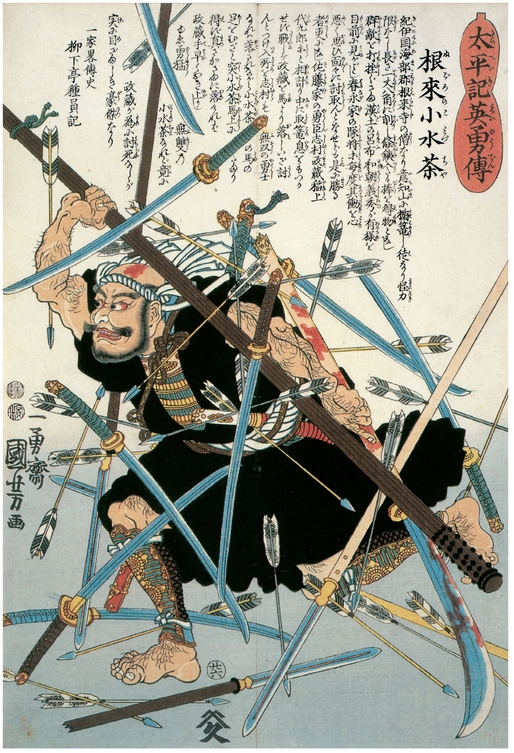
26. Negoro-no Komizucha. Komizucha was a sohei, a warrior-monk, shown here in battle armed not with the samurai’s weapons, but instead with just a massive club—even so he seems to be holding his own against a fusillade of spears, swords, and arrows.

27. Araki Settsu-no kami Murashige. This print depicts a powerful warrior, Araki Murashige, wearing ceremonial dress and an official hat and surrounded by the accoutrements of status and authority including the elegant sword-sheath and the lacquer table, but posed in a humble position with a rice cake in his mouth. The text reveals that the warrior has just accepted the cake from the knife of his master as a sign of loyalty and respect.
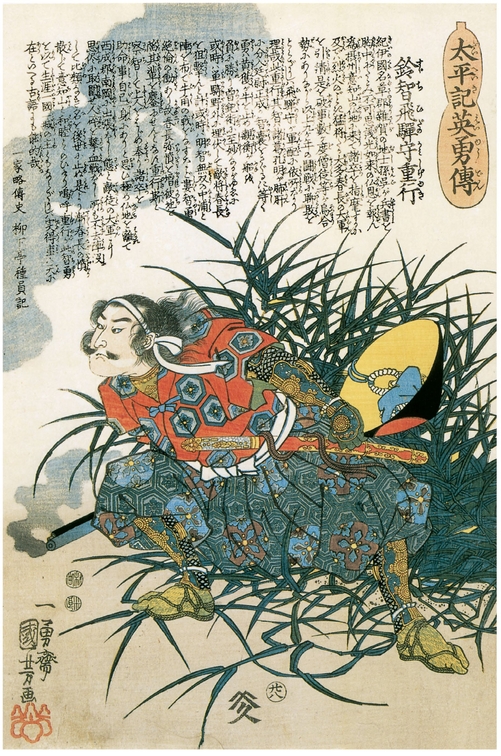
28. Suzuki Shigehide. Samurai Suzuki Shigehide is shown with many of the Japanese warrior’s traditional weapons, but also with a smoking firearm in his right hand. The Portuguese brought the first firearms to Japan in 1542, and the first Japanese muskets were being produced there very shortly thereafter.
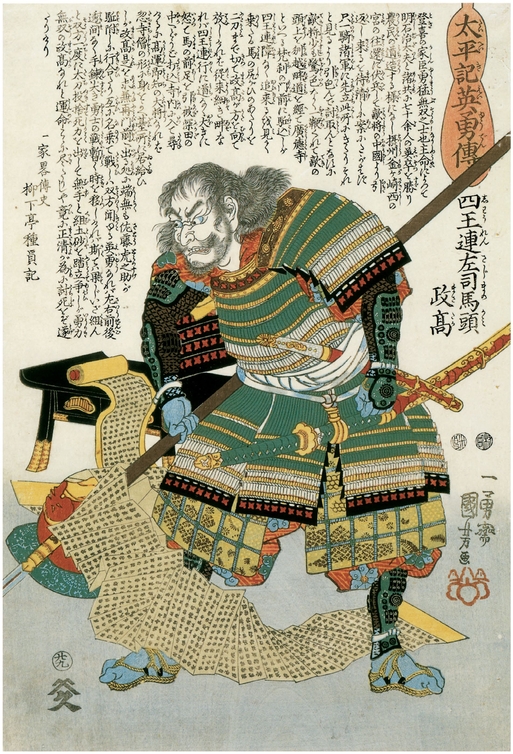
29. Shi den Tajima-no-kami Masataka. Depicting a famous incident from the battles of this period, Shi
den Tajima-no-kami Masataka. Depicting a famous incident from the battles of this period, Shi den is searching in a temple for his enemy Hideyoshi, and has encountered there a lengthy sutra scroll, which he engages with his sword.
den is searching in a temple for his enemy Hideyoshi, and has encountered there a lengthy sutra scroll, which he engages with his sword.
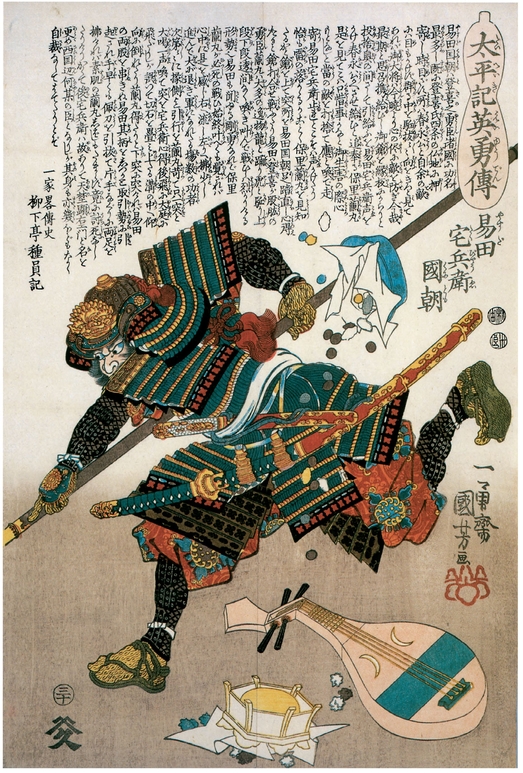
30. Yasuda Sakubee Kunitsugu. Samurai Yasuda Kunitsugu is depicted in a famous attack on his enemy Oda Nobunaga at the temple of Honnoji. Here the warrior proceeds at full throttle across an interior filled with symbolically peaceful objects—the lute on the floor and an overturned box of sweets make it clear that this was not a traditional battlefield.
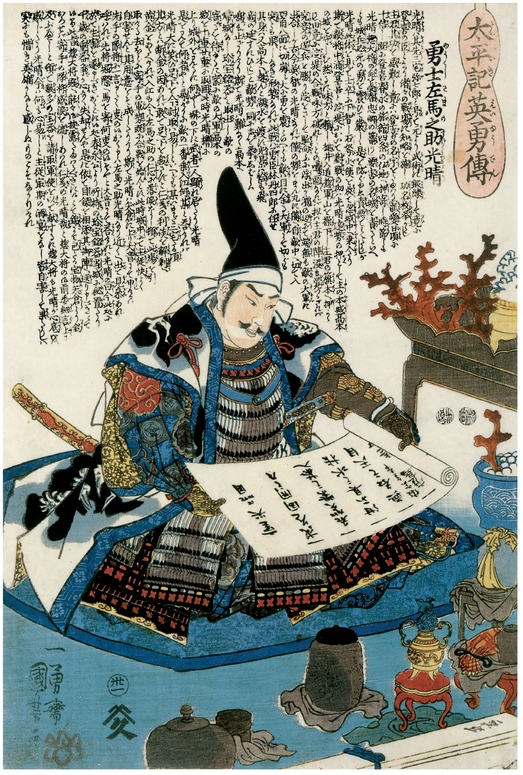
31. Akechi Samanosuke Mitsuharu. Mitsuharu is reading from a scroll listing valuable objects which had belonged to the now-deceased warlord Oda Nobunaga, part of the process of transferring them to those fighting on in Nobunaga’s memory.
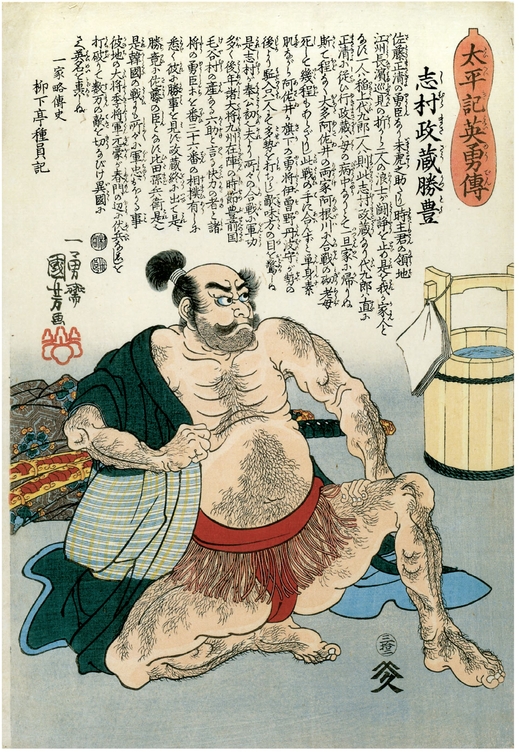
32. Kimura Mataz Shigekatsu. The samurai Kimura is portrayed here as a sumo wrestler. The source of this image was a legendary incident when the warrior, in a military encampment, had defeated an actual sumo wrestler who was widely considered invincible.
Shigekatsu. The samurai Kimura is portrayed here as a sumo wrestler. The source of this image was a legendary incident when the warrior, in a military encampment, had defeated an actual sumo wrestler who was widely considered invincible.
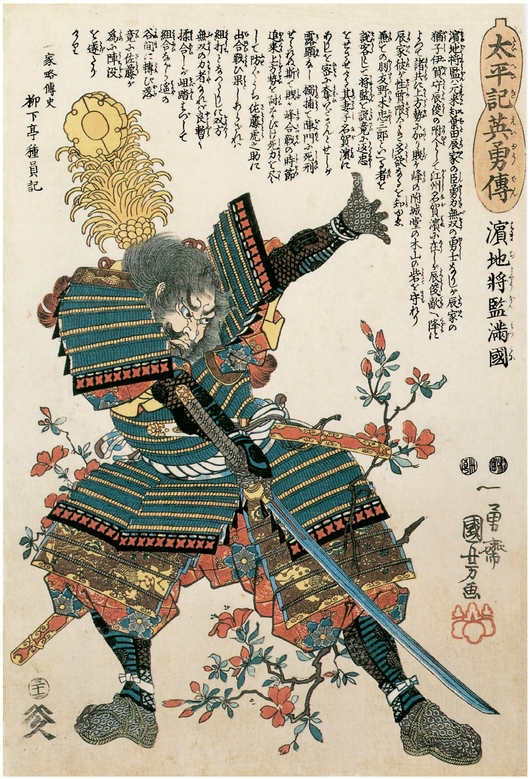
33. Yamaji Sh gen Masakuni. A powerful warrior, Yamaji Sh
gen Masakuni. A powerful warrior, Yamaji Sh gen brandishes his long sword in a fierce battle with an unseen opponent. The presence of blooming azalea branches in this composition was intended by Kuniyoshi, according to a traditional symbolism, to indicate subtly that this was the great samurai’s last fight.
gen brandishes his long sword in a fierce battle with an unseen opponent. The presence of blooming azalea branches in this composition was intended by Kuniyoshi, according to a traditional symbolism, to indicate subtly that this was the great samurai’s last fight.
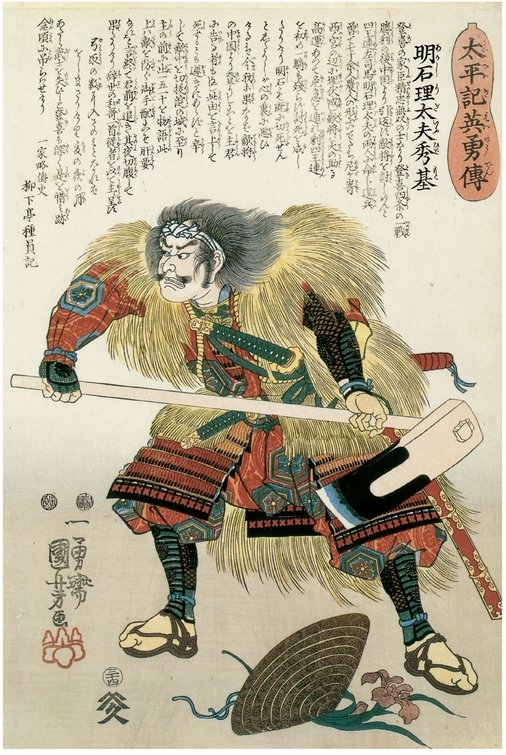
34. Akashi Giday Tadamasu. Akashi has attempted to disguise his samurai’s armor and weaponry with a peasant’s hat and a coat of straw, but the huge sharpened hoe, very different from any hoe an actual peasant might use, looks just as lethal as any weapon the samurai might ordinarily carry. The iris flower at the bottom is a traditional symbol of manhood.
Tadamasu. Akashi has attempted to disguise his samurai’s armor and weaponry with a peasant’s hat and a coat of straw, but the huge sharpened hoe, very different from any hoe an actual peasant might use, looks just as lethal as any weapon the samurai might ordinarily carry. The iris flower at the bottom is a traditional symbol of manhood.
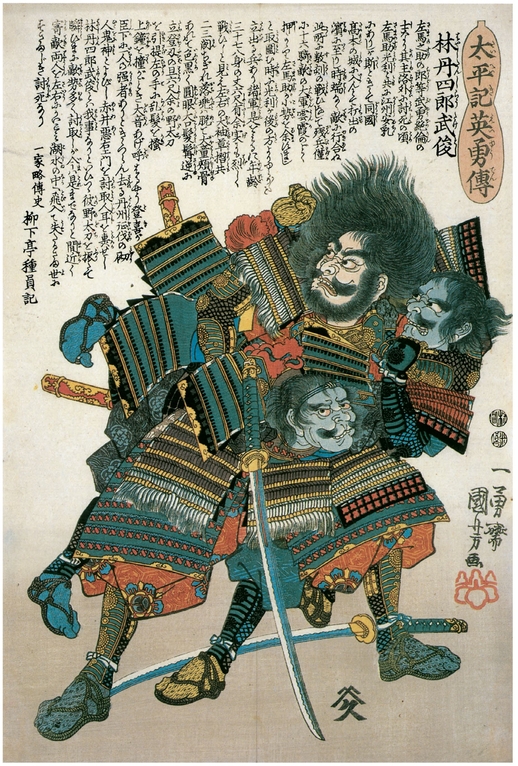
35. Hayashi Hanshir Taketoshi. In a legendary battle, samurai Hayashi Hanshir
Taketoshi. In a legendary battle, samurai Hayashi Hanshir is shown carrying two fully armed opponents off the battlefield, squeezing them so violently that they are turning gray from suffocation.
is shown carrying two fully armed opponents off the battlefield, squeezing them so violently that they are turning gray from suffocation.
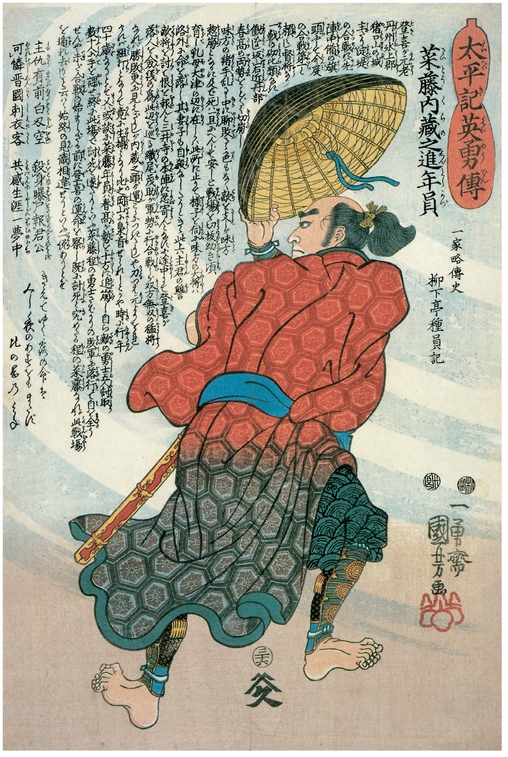
36. Sait Kuranosuke Toshimitsu. There were circumstances when flight was a reasonable course of action. Here the barefoot Sait
Kuranosuke Toshimitsu. There were circumstances when flight was a reasonable course of action. Here the barefoot Sait Kuranosuke hides his face with a peasant’s hat to try to avoid recognition by his pursuers—in this case, the deception was not successful.
Kuranosuke hides his face with a peasant’s hat to try to avoid recognition by his pursuers—in this case, the deception was not successful.
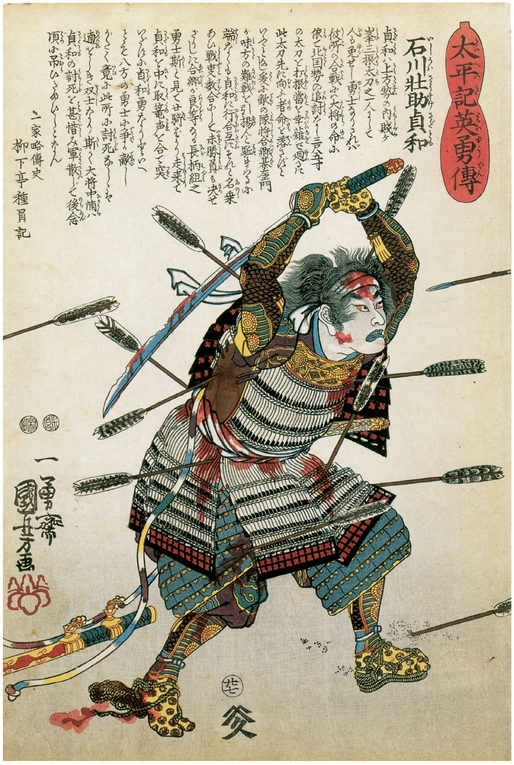
37. Ishikawa Hy suke Kazumitsu. In this unusual image Kuniyoshi depicted the indomitable samurai spattered with blood from his many wounds while fighting on with upraised sword though pierced by several arrows.
suke Kazumitsu. In this unusual image Kuniyoshi depicted the indomitable samurai spattered with blood from his many wounds while fighting on with upraised sword though pierced by several arrows.

38. Akechi J r
r zaemon Mitsuchika. This is the only print in this set in which Kuniyoshi depicted a battlefield following a furious fight. In one version of this narrative, Akechi Mitsuchika, the samurai shown here, camouflaged himself among the many corpses to have a chance to spring up and attack his major enemy.
zaemon Mitsuchika. This is the only print in this set in which Kuniyoshi depicted a battlefield following a furious fight. In one version of this narrative, Akechi Mitsuchika, the samurai shown here, camouflaged himself among the many corpses to have a chance to spring up and attack his major enemy.
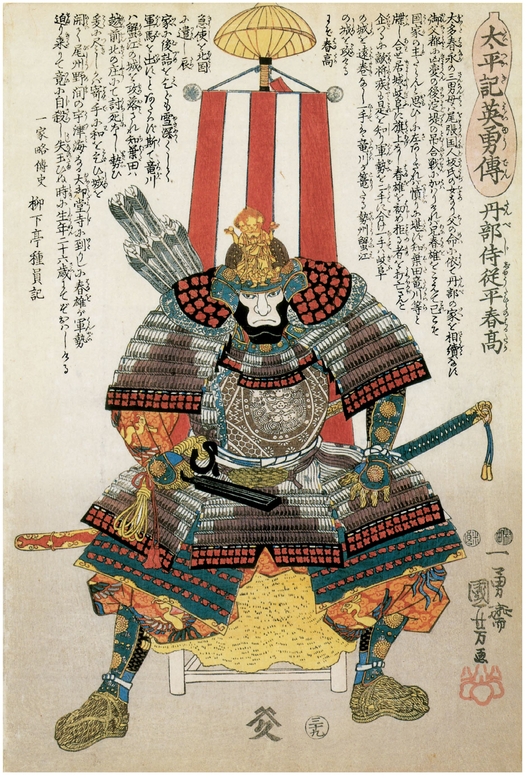
39. Oda Nobutaka. The samurai is sitting on a campstool covered with a fur rug. Behind him is his personal banner with a karakasa, a Chinese umbrella, attached at the top. As part of his armor, the seated samurai is wearing a hoate, a protective facemask that covers his cheeks and chin.
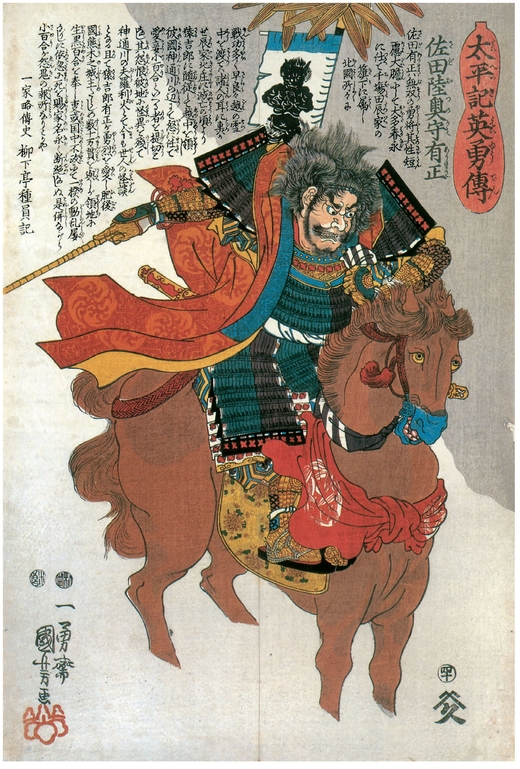
40. Sassa Narimasa. A dramatic scene portrays the samurai on horseback on the side of a mountain in a winter storm. The horse’s legs disappearing in the snow and the warrior’s wild hair and waving garments confirm the ferocity of the weather.
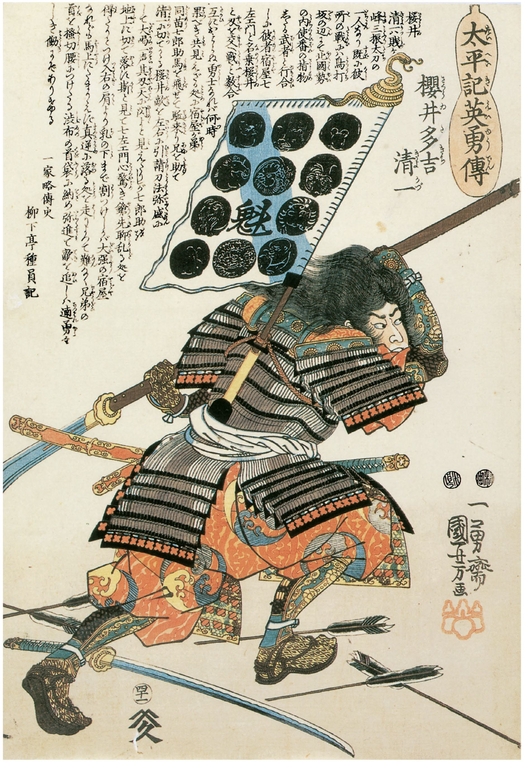
41. Sakurai Sakichi Iekazu. The samurai, in full spear attack, is oblivious to the arrows at his feet. His sashimono, or personal standard, displays eleven of the twelve zodiac animals. The snake, rendered instead in gold at the top of the standard, has been replaced in the middle of the second row from the bottom by the character which means “charging ahead of others.”
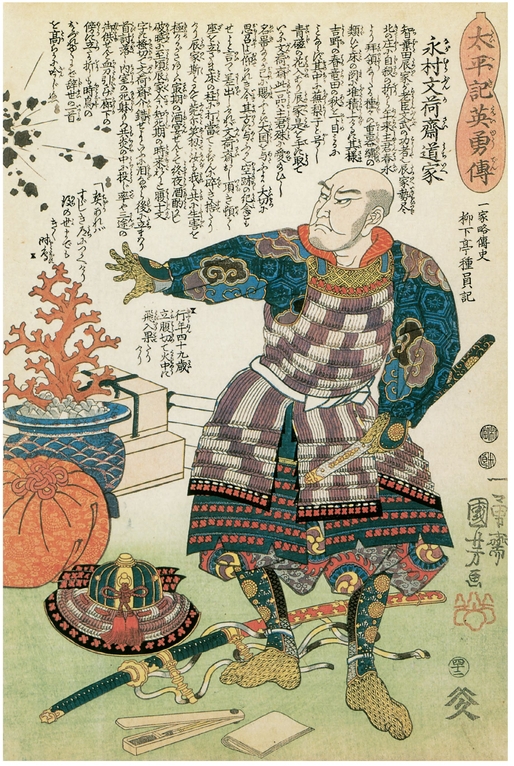
42. Nakamura Bunkasai. With fortune no longer on his side, Nakamura Bunkasai, his face a mask of resolution, prepares to end his life by committing seppuku. Fragments of a vase, a gift from his lord, are shown at the upper left—the samurai declared his intention not to live after his lord’s death by destroying this valued present. At his feet are the brush case and paper he will use to compose a farewell poem before taking his life.
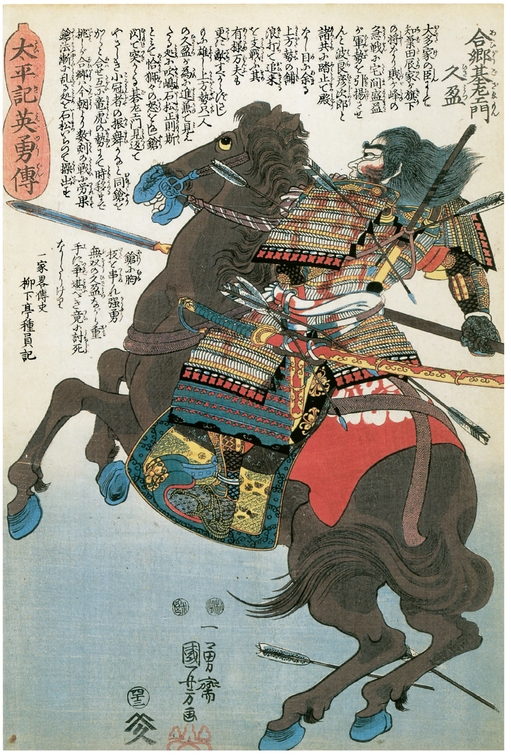
43. Haig Gozaemon Hisamitsu. This is one of the two prints in this series in which Kuniyoshi depicted a samurai on horseback. Wounded and spattered with blood, his standard destroyed, the samurai aims his spear at the unseen enemy and urges his horse on, away from the viewer.
Gozaemon Hisamitsu. This is one of the two prints in this series in which Kuniyoshi depicted a samurai on horseback. Wounded and spattered with blood, his standard destroyed, the samurai aims his spear at the unseen enemy and urges his horse on, away from the viewer.
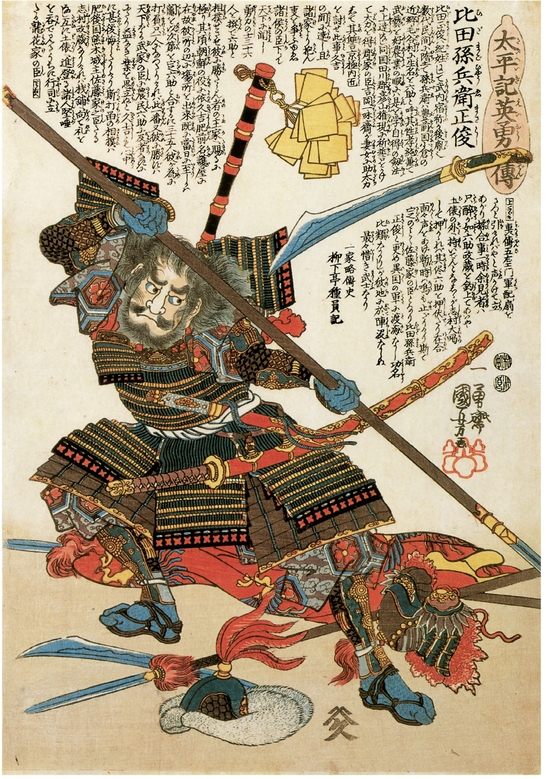
44. Kida Magobee Muneharu. Kuniyoshi depicted Kida Magobee fighting in this print with weapons, both the sword on the ground and the one in the air, of Manchurian design. This samurai died in battle in the Manchurian area of Orangai, north of Korea.
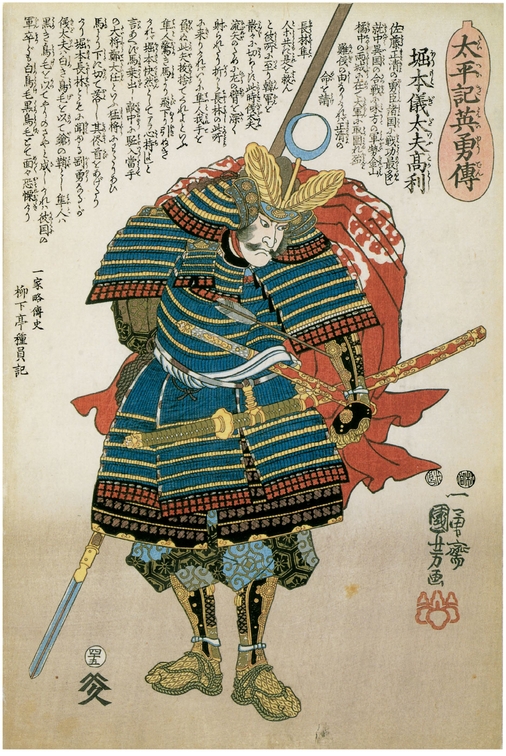
45. Morimoto Giday Hidetora. The fully armed warrior gazes with stoic curiosity, but displays no sense of urgency, at the enemy arrow which has pierced his left arm.
Hidetora. The fully armed warrior gazes with stoic curiosity, but displays no sense of urgency, at the enemy arrow which has pierced his left arm.
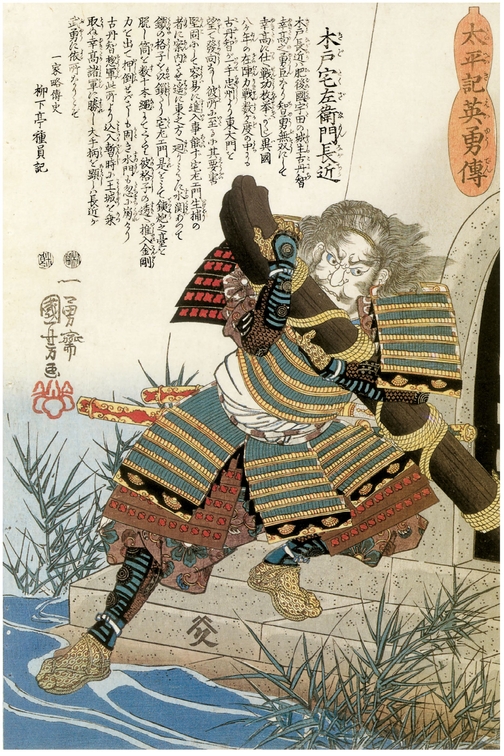
46. Kido Sakuzaemon Norishige. The powerful samurai attacks the iron gates of a man-made waterway with a heavy piece of improvised equipment, a massive wooden sledge.
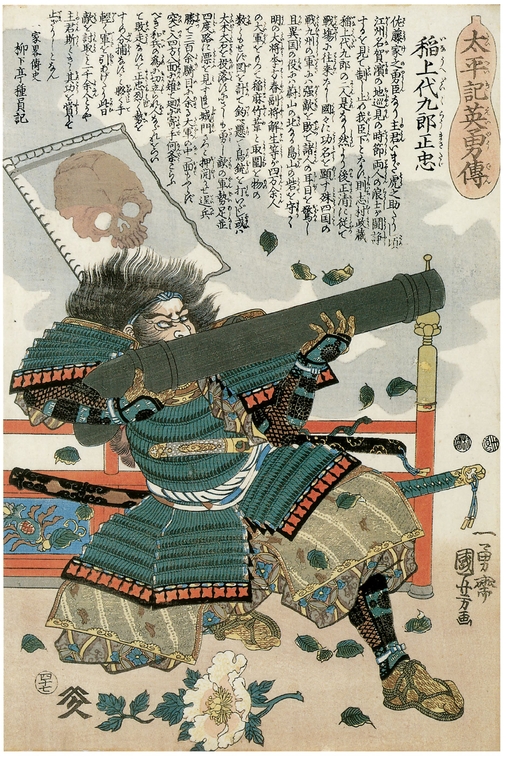
47. Inoue Daikur Nagayoshi. Inoue Daikur
Nagayoshi. Inoue Daikur is shown firing an improbably large hand-held cannon, possibly in battle with Chinese troops. The peony, a traditional symbol of affluence in China, here lies on the ground at the feet of the Japanese warrior.
is shown firing an improbably large hand-held cannon, possibly in battle with Chinese troops. The peony, a traditional symbol of affluence in China, here lies on the ground at the feet of the Japanese warrior.
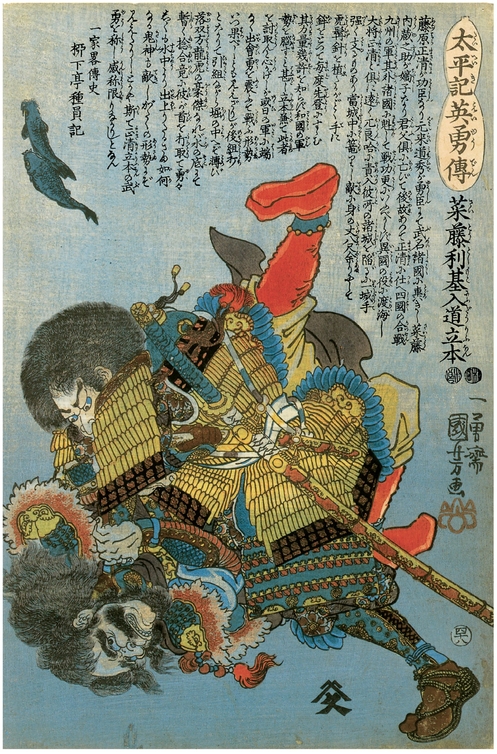
48. Sait Toshimitsu ny
Toshimitsu ny d
d Ry
Ry hon. The two fish swimming upward in the overall gray-blue background identify this as a scene of underwater hand-to-hand combat between the Japanese samurai with his traditional equipment and his Manchurian opponent.
hon. The two fish swimming upward in the overall gray-blue background identify this as a scene of underwater hand-to-hand combat between the Japanese samurai with his traditional equipment and his Manchurian opponent.
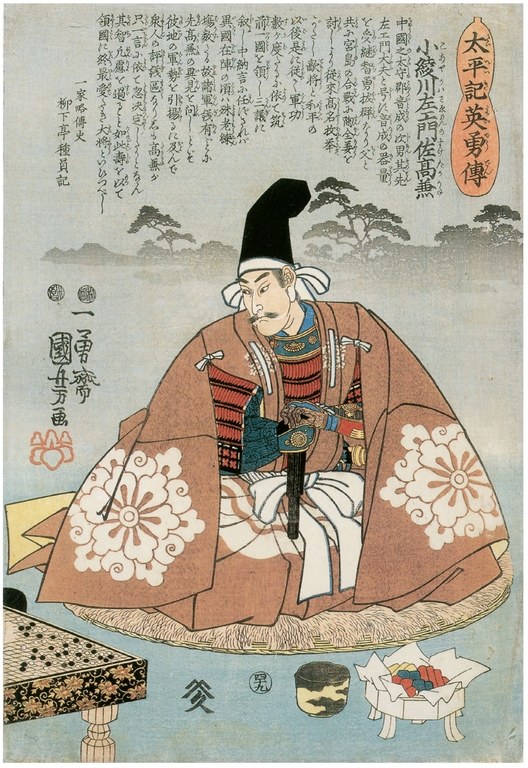
49. Kobayakawa Takakage. Kobayakawa was as renowned for his intelligence and wisdom as governor of his people as for his prowess as a warrior. Here he wears his official cloak over his samurai’s armor, and the items in front of him in the foreground confirm his status as a wise and intellectual man committed to peace in the area he ruled—the box of sweets, the cup for the tea ceremony, and the go board at which he stares, contemplating his next move.
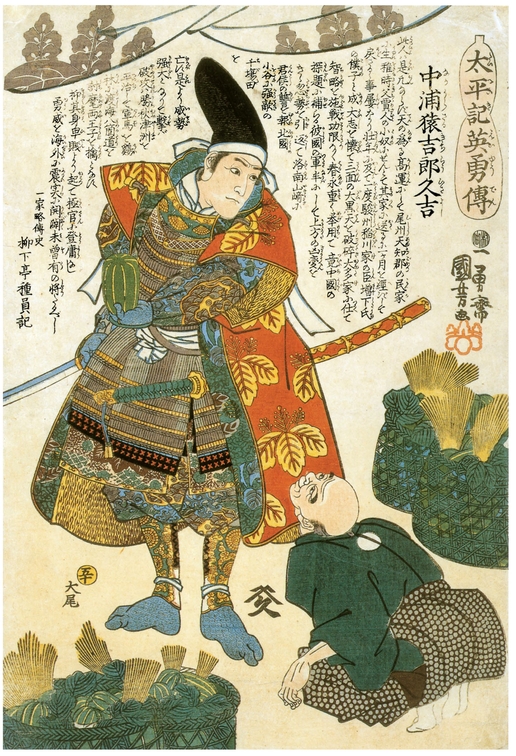
50. Toyotomi Hideyoshi. Hideyoshi holds a melon in his left hand, a gift to the samurai’s troops from the farmer kneeling at his feet. As he distributed the gift of melons to his troops, Hideyoshi contrasted the loyalty of the peasant with the treacherousness of some of his more powerful enemies.The samurai’s robe and the tent flap above him are decorated with a paulownia crest. The artist Kuniyoshi also used the paulownia image in his artist’s seal seen here on the right in red below his signature.
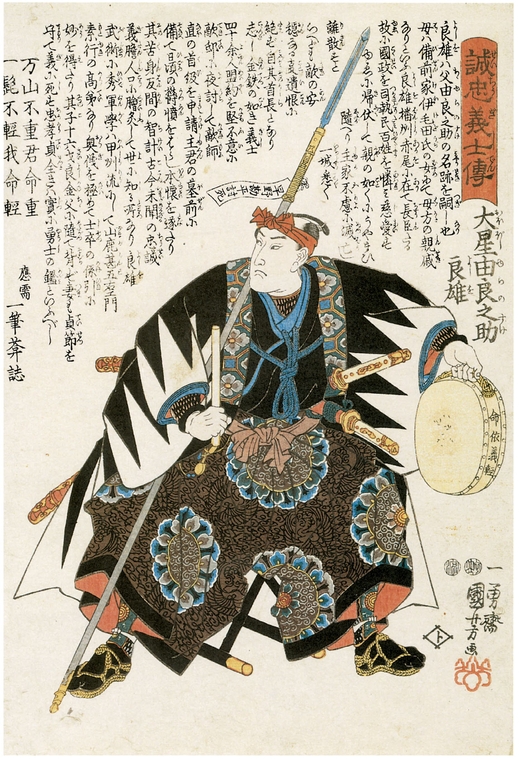
51.  boshi Yuranosuke Yoshio. The samurai is seated on a campstool, beating a drum.
boshi Yuranosuke Yoshio. The samurai is seated on a campstool, beating a drum. boshi, leader of the attack on December 14, 1702, gave the signal to proceed to his troops with such a drum, and used it to direct the 47 r
boshi, leader of the attack on December 14, 1702, gave the signal to proceed to his troops with such a drum, and used it to direct the 47 r nin in their successful battle that night. (The full name of the enemy of the 47 r
nin in their successful battle that night. (The full name of the enemy of the 47 r nin was K
nin was K no Musashi no Kami Moronao. For the sake of simplicity, the attack on his mansion is often referred to in these captions as “the K
no Musashi no Kami Moronao. For the sake of simplicity, the attack on his mansion is often referred to in these captions as “the K no attack”).
no attack”).
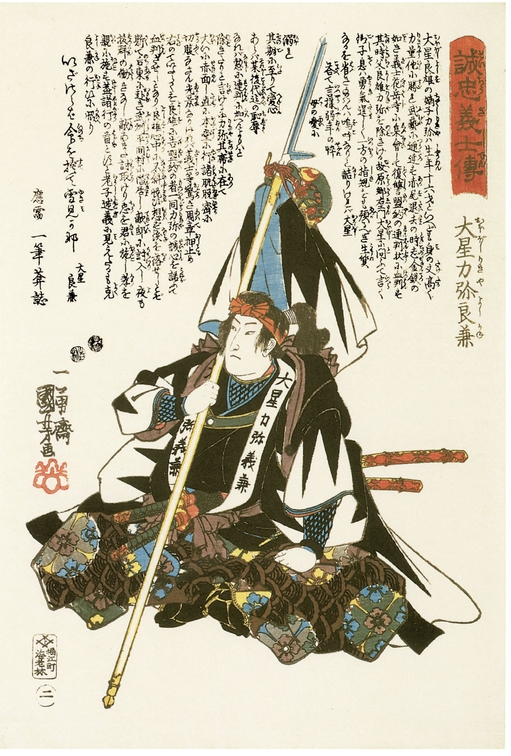
52.  boshi Rikiya Yoshikane. A young samurai, Oboshi Rikiya, is seated with his spear, to which are attached his helmet and cape.
boshi Rikiya Yoshikane. A young samurai, Oboshi Rikiya, is seated with his spear, to which are attached his helmet and cape.
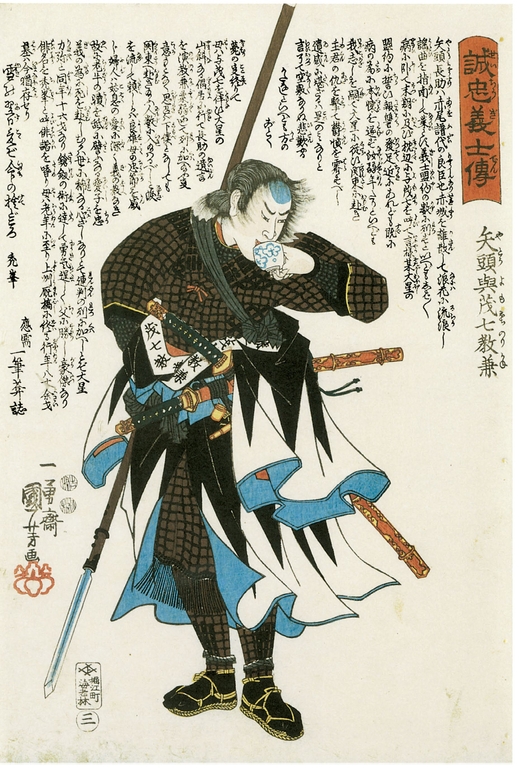
53. Yat Yomoshichi Norikane. Drinking from a decorated cup, samurai Yat
Yomoshichi Norikane. Drinking from a decorated cup, samurai Yat Yomoshichi is prepared for battle with the samurai’s standard weaponry, the two swords and the spear.
Yomoshichi is prepared for battle with the samurai’s standard weaponry, the two swords and the spear.
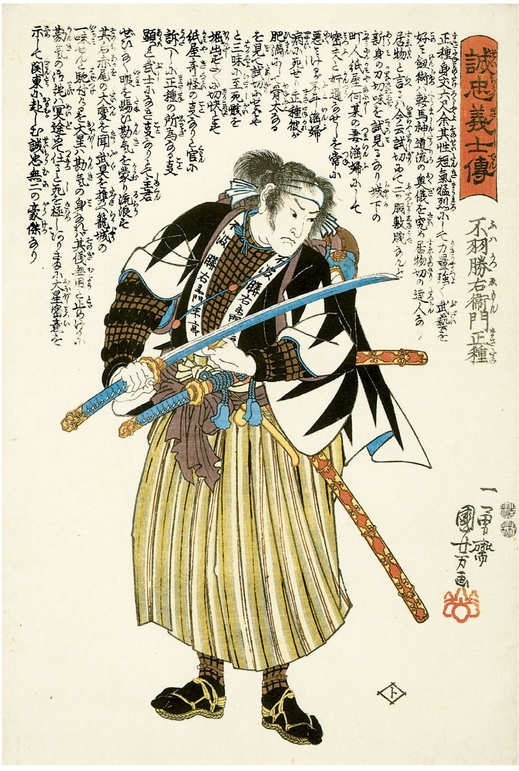
54. Fuwa Katsuemon Masatane. Examining the sharp edge of his longer sword, the samurai is wearing the same dog-tooth pattern cape worn by most of the warriors pictured in this series of prints.
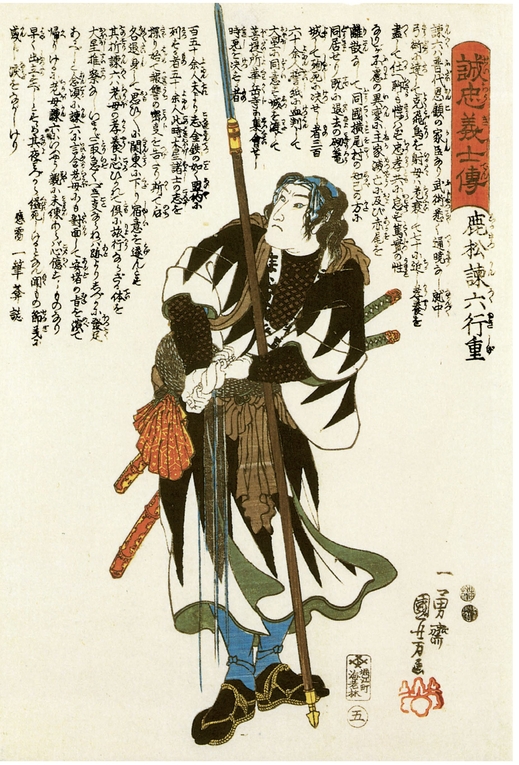
55. Shikamatsu Kanroku Yukishige. Before the attack on December 14, 1702, the aged mother of this warrior committed suicide so he would not be dissuaded from doing his military duty because of his concern for her well-being. Kanroku is shown here with a sad expression, wringing water—which stands symbolically for his tears for his mother—from his sleeve.
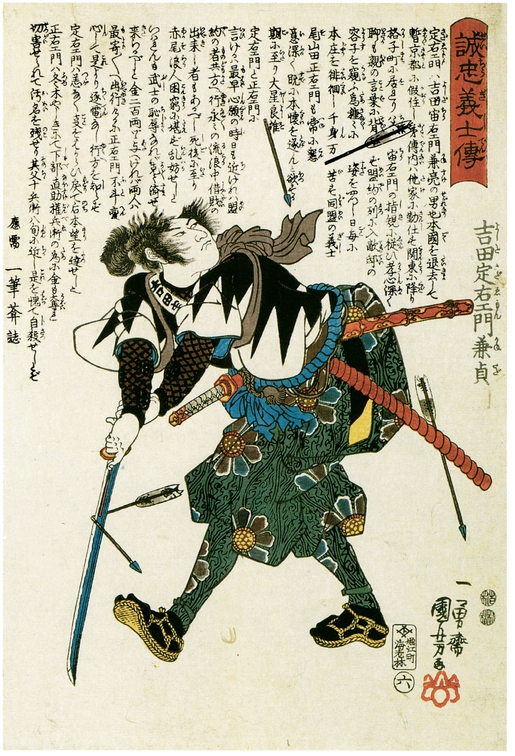
56. Yoshida Sadaemon Kanesada. A theme often revisited in samurai prints, the warrior is fending off arrows with his sword.
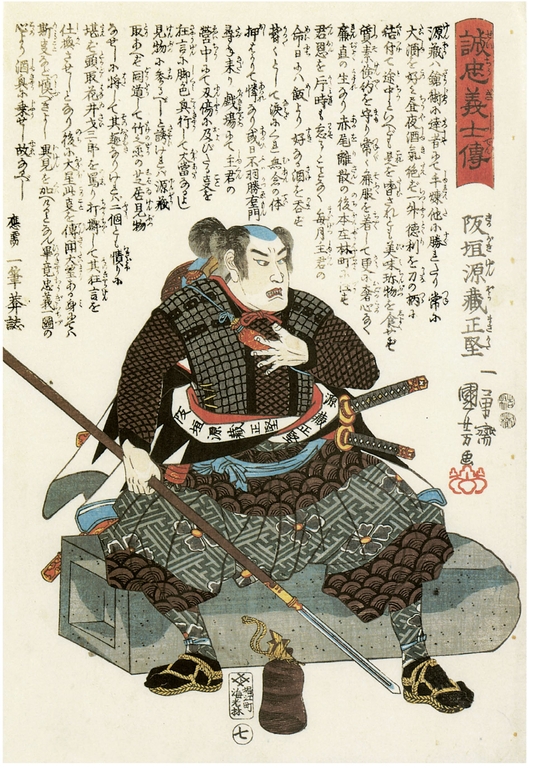
57. Sakagaki Genz Masakata. Genz
Masakata. Genz was known to enjoy his sake more than most of his comrades. Here he is sitting with his sake pitcher on the ground in front of him, serving as a canteen.
was known to enjoy his sake more than most of his comrades. Here he is sitting with his sake pitcher on the ground in front of him, serving as a canteen.
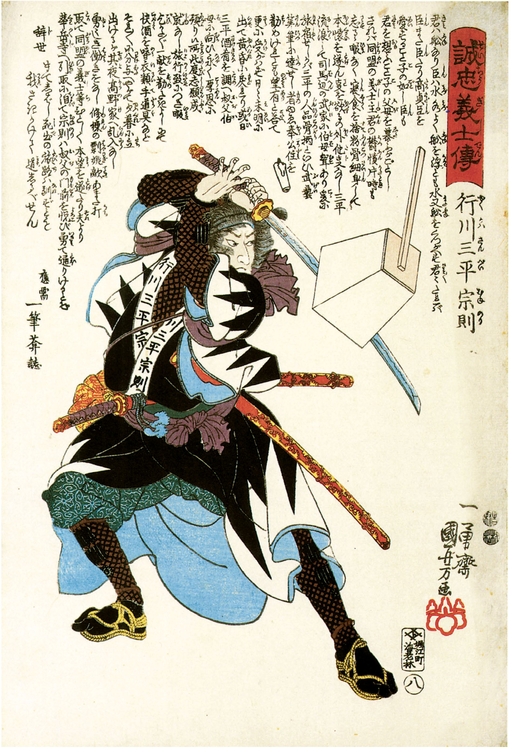
58. Yukukawa Sampei Munenori. The famous attack of 1702, the subject of this series of prints, was an attack on a mansion and many of the prints show domestic details, often in a slyly humorous way. Here the warrior in battle has encountered a lantern which he dispatches with his sword.
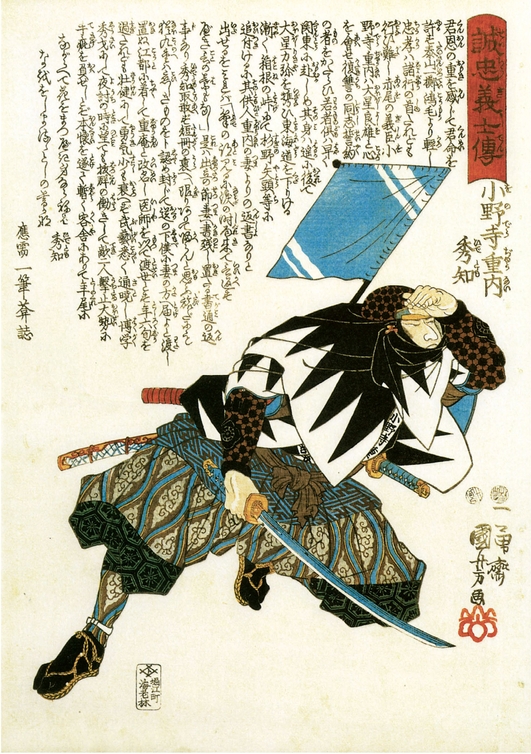
59. Onodera J nai Hidetomo. The samurai in a fighting position resting on one knee, shading his eyes.
nai Hidetomo. The samurai in a fighting position resting on one knee, shading his eyes.
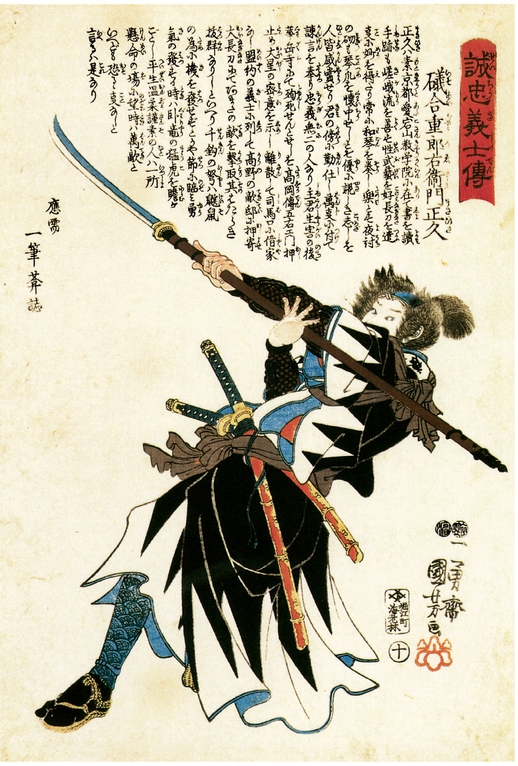
60. Isoai J roemon Masahisa. This warrior was famous for being particularly adept with the naginata, the glaive or spear which the samurai carried along with their swords. He used it to kill many enemy warriors on the night of the K
roemon Masahisa. This warrior was famous for being particularly adept with the naginata, the glaive or spear which the samurai carried along with their swords. He used it to kill many enemy warriors on the night of the K no attack.
no attack.
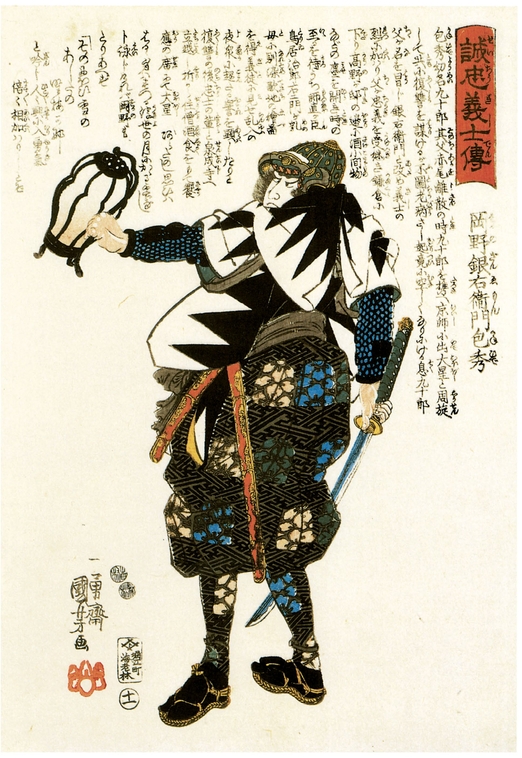
61. Okano Gin-emon Kanehide. One of the youngest samurai who took part in the K no attack, Okano is shown here holding a lantern.
no attack, Okano is shown here holding a lantern.
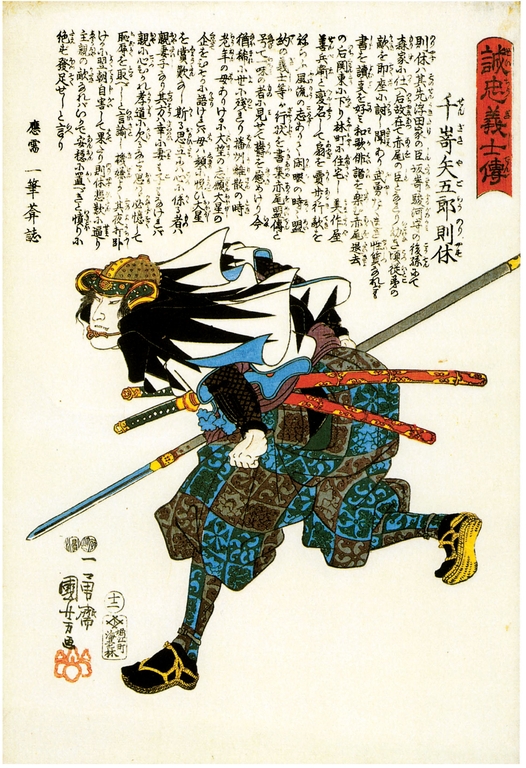
62. Senzaki Yagor Noriyasu. The warrior running with his weapons.
Noriyasu. The warrior running with his weapons.
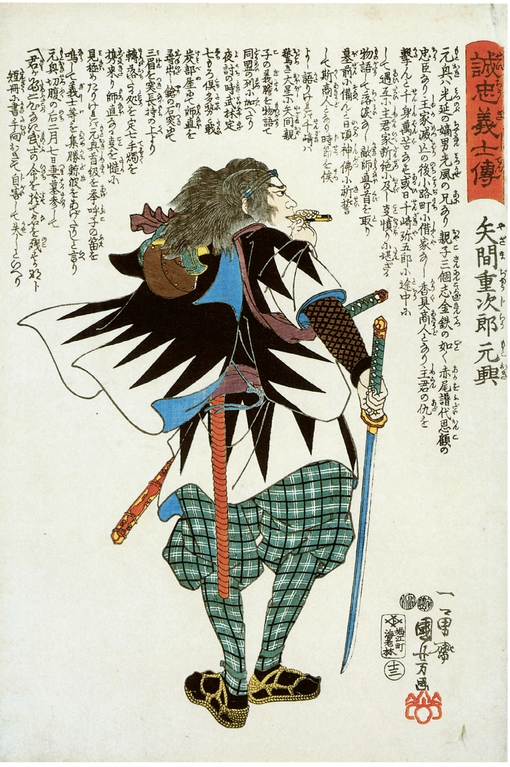
63. Yazama J jir
jir Moto-oki. Moto-oki used his whistle on the night of the K
Moto-oki. Moto-oki used his whistle on the night of the K no attack to call his comrades after he had discovered and decapitated the enemy Moronao, thereby ending the battle.
no attack to call his comrades after he had discovered and decapitated the enemy Moronao, thereby ending the battle.
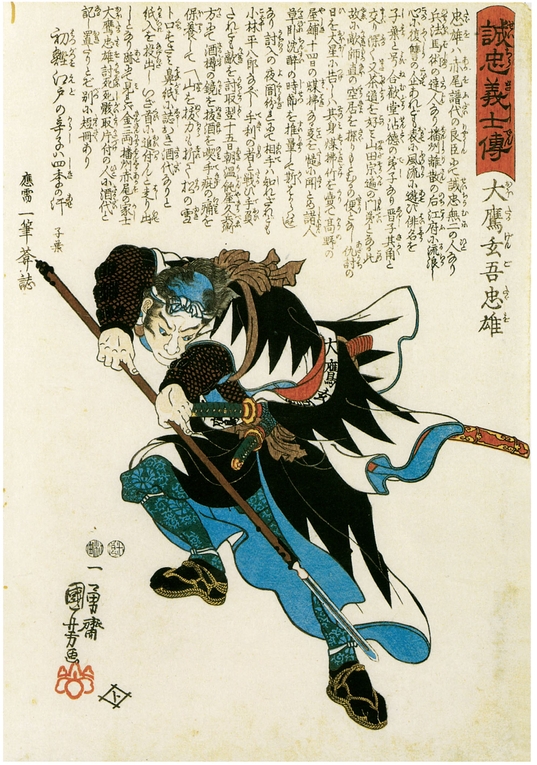
64.  taka Gengo Tadao. The samurai takes aim with his spear.
taka Gengo Tadao. The samurai takes aim with his spear.
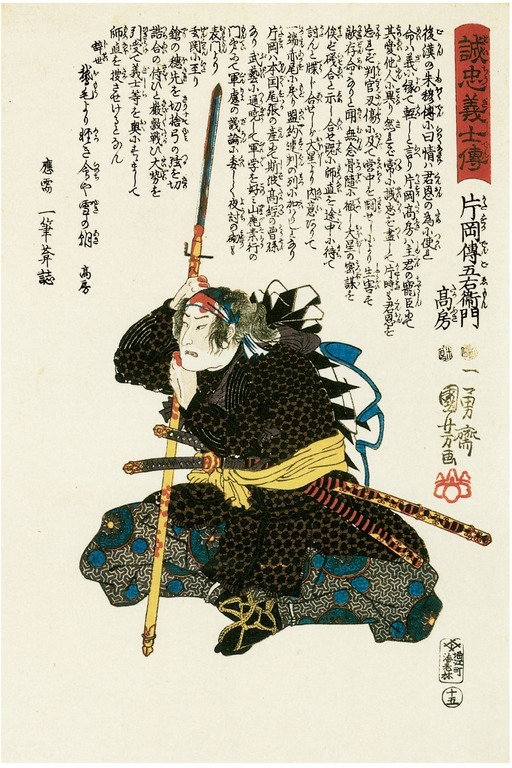
65. Kataoka Dengoemon Takafusa. Shown during a brief respite in the heat of battle, Kataoka is leaning on his bloodstained spear, with blood also spattered on his hands, swords, and headband.
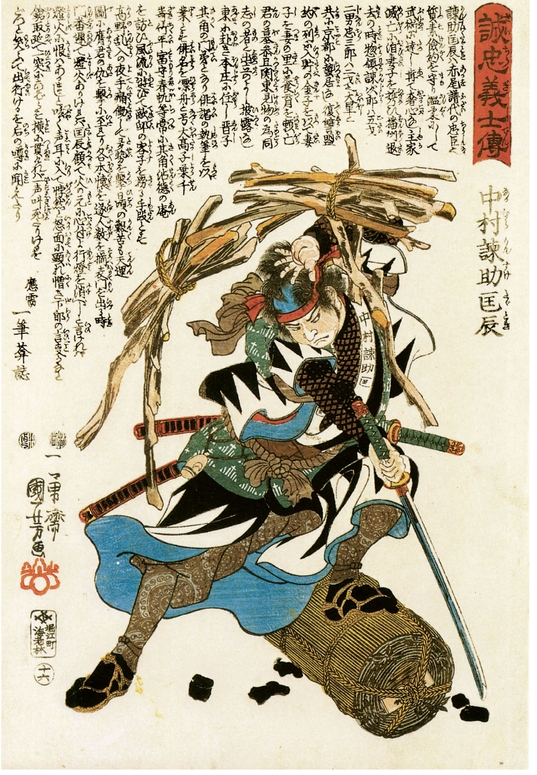
66. Nakamura Kansuke Tadatoki. In the midst of the K no attack, Tadatoki encounters some hostile charcoal and kindling wood in the mansion’s kitchen area.
no attack, Tadatoki encounters some hostile charcoal and kindling wood in the mansion’s kitchen area.
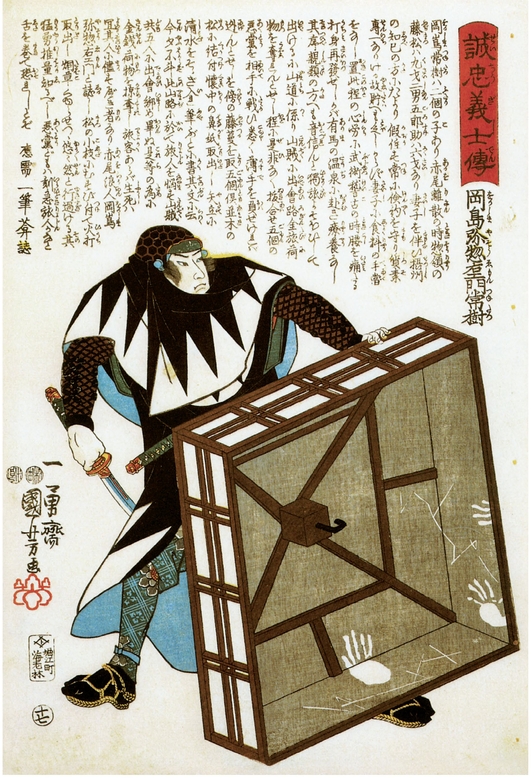
67. Okashima Yas emon Tsunetatsu. In another quasi-domestic scene, Okashima finds some impromptu protection behind the cover of an id
emon Tsunetatsu. In another quasi-domestic scene, Okashima finds some impromptu protection behind the cover of an id or floor fireplace.
or floor fireplace.
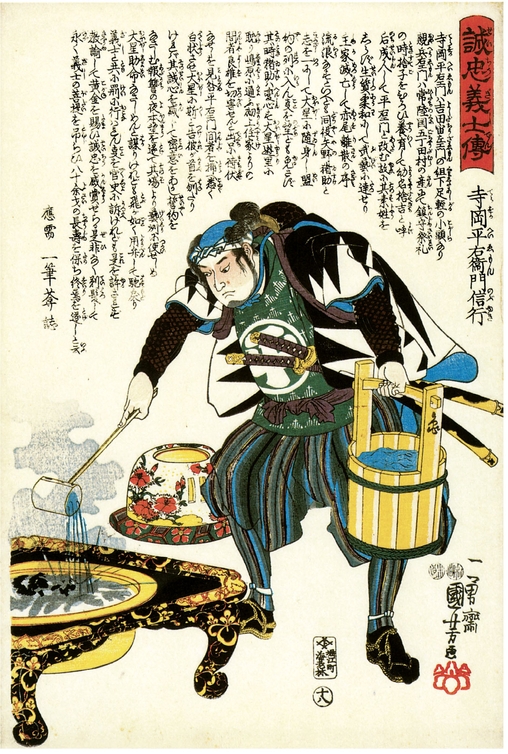
68. Teraoka Hei-emon Nobuyuki. The loyal Hei-emon extinguishing the fire in a hibachi. Before leaving the K no mansion, the attackers under Oboshi were careful to extinguish all fires to insure that none of the neighbors’ houses would be destroyed accidentally.
no mansion, the attackers under Oboshi were careful to extinguish all fires to insure that none of the neighbors’ houses would be destroyed accidentally.
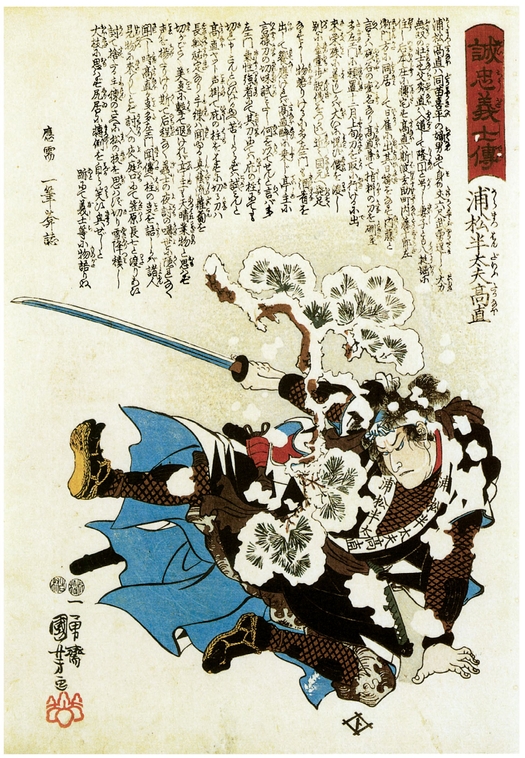
69. Uramatsu Handay Takanao. Takanao was a master swordsman and often practiced his technique by felling pine branches. On at least one occasion a large branch covered with snow knocked the samurai over backwards, a story he laughed about with his comrades.
Takanao. Takanao was a master swordsman and often practiced his technique by felling pine branches. On at least one occasion a large branch covered with snow knocked the samurai over backwards, a story he laughed about with his comrades.
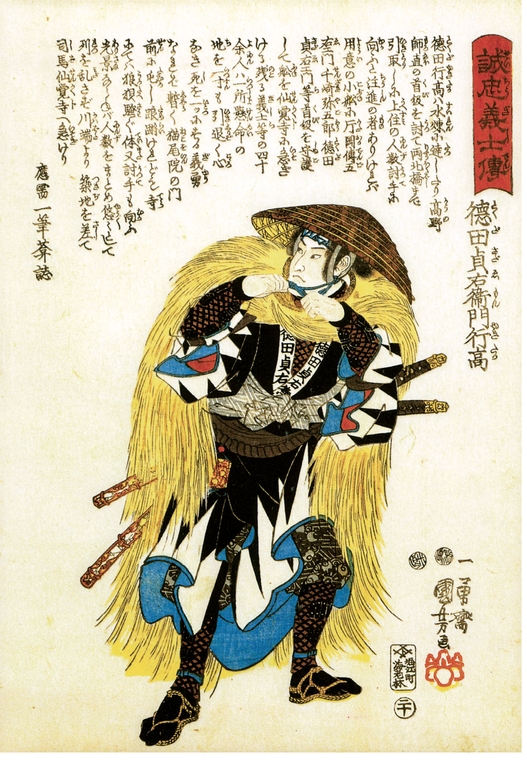
70. Tokuda Sadaemon Yukitaka. The samurai wears a broad hat and a straw mantle to protect his armor and equipment from the rain.
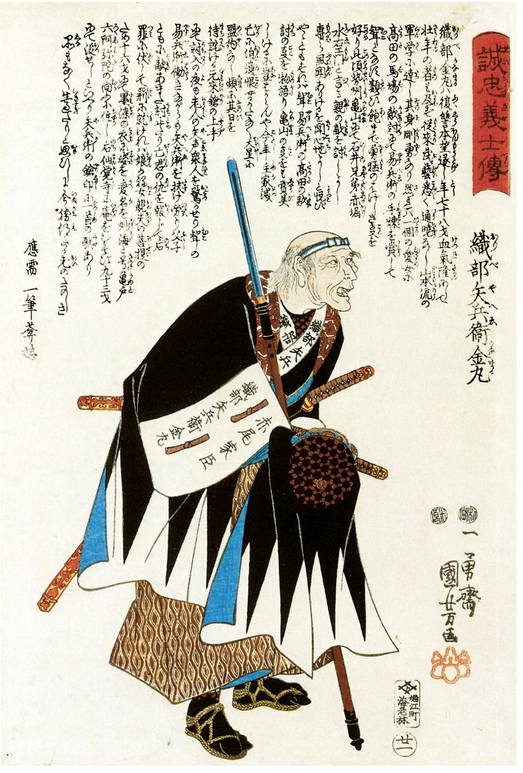
71. Oribe Yahei Kanamaru. Kanamaru was, at 78, the oldest warrior to take part in the K no attack. He was especially skillful with the spear and did well in the battle. The banner on his spear identifies his name and clan.
no attack. He was especially skillful with the spear and did well in the battle. The banner on his spear identifies his name and clan.
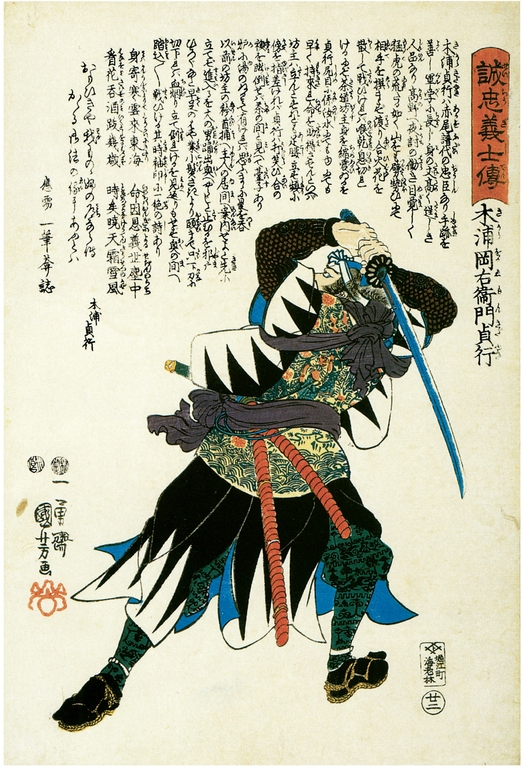
72. Kiura Okaemon Sadayuki. The samurai poised to strike with his sword.
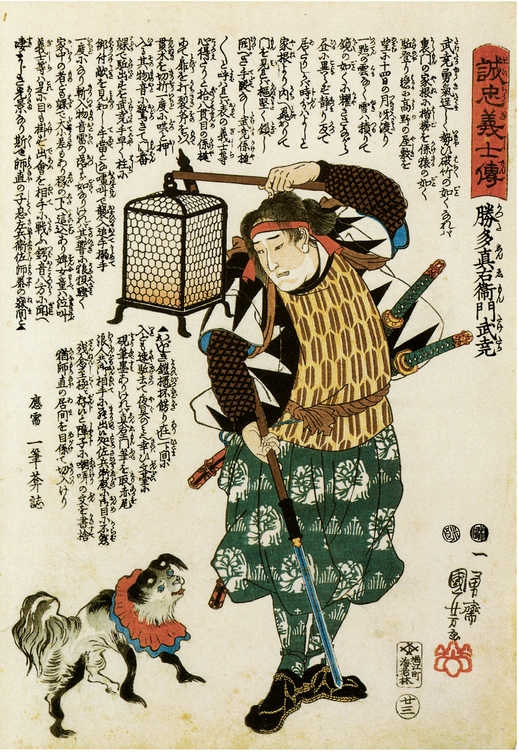
73. Katsuta Shinemon Taketaka. A humorous reminder that the K no attack took place at night, the heavily armed samurai is here also burdened with a large and clumsy lamp when he encounters an elegant small dog in the K
no attack took place at night, the heavily armed samurai is here also burdened with a large and clumsy lamp when he encounters an elegant small dog in the K no mansion.
no mansion.
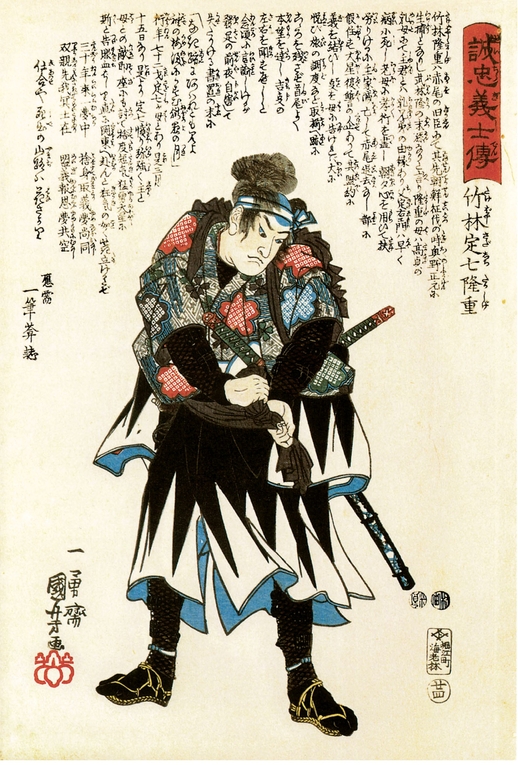
74. Takebayashi Sadashichi Takashige. The samurai tying his waistband before the battle.
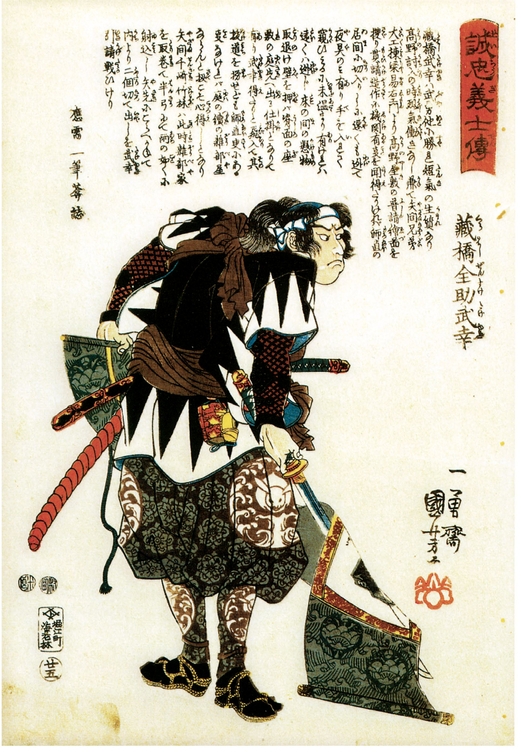
75. Kurahashi Zensuke Takeyuki. Takeyuki was in on the finish at the K no mansion when the enemy Moronao was discovered in the storage shed in the garden. In this print he stands in the mansion with a displaced wall scroll over his sword.
no mansion when the enemy Moronao was discovered in the storage shed in the garden. In this print he stands in the mansion with a displaced wall scroll over his sword.
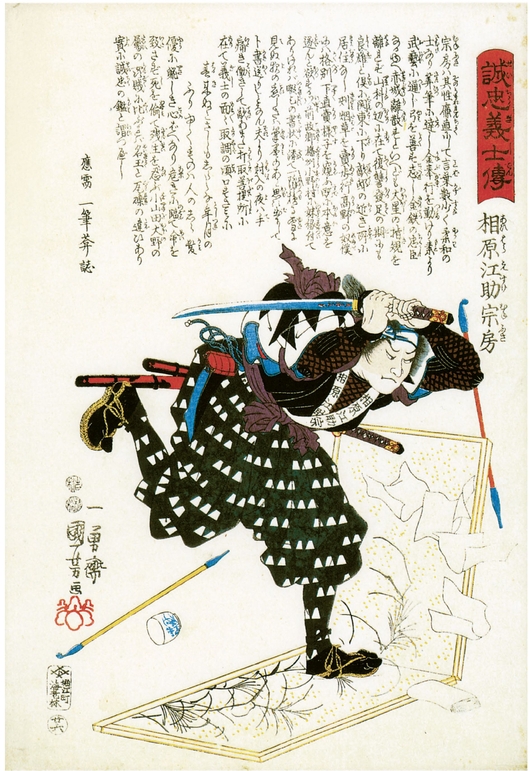
76. Aihara Esuke Munefusa. Munefusa running at full tilt brandishing his sword. He is running over a low screen which has been knocked over. The flying cup, long pipes, and sheets of writing paper indicate that a domestic scene has been interrupted in this attack.
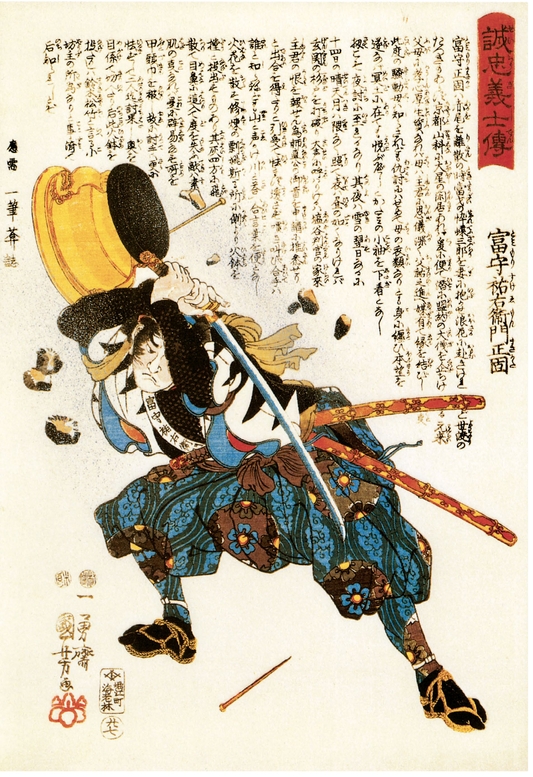
77. Tominomori Suke-emon Masakata. Tominomori dodges a hibachi thrown at him during the K no attack. The printmaker applied metallic powder to the print after printing this image to indicate the coal dust thrown up by the hibachi.
no attack. The printmaker applied metallic powder to the print after printing this image to indicate the coal dust thrown up by the hibachi.
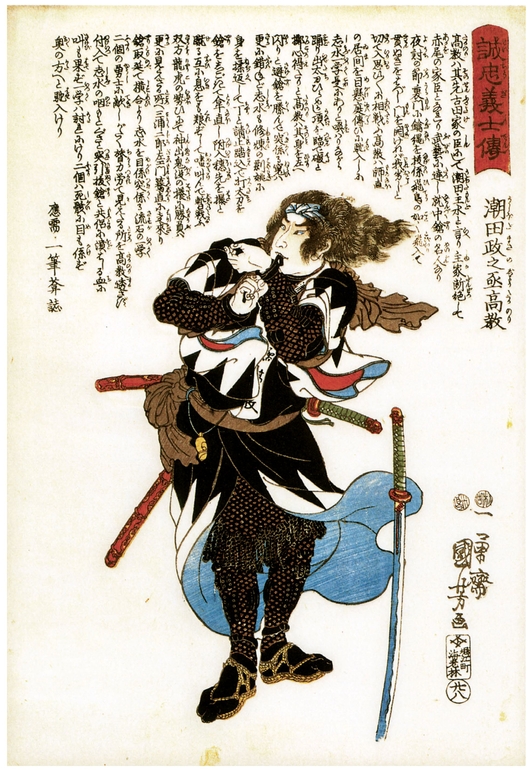
78. Ushioda Masanoj Takanori. The samurai fastening his wrist strap.
Takanori. The samurai fastening his wrist strap.
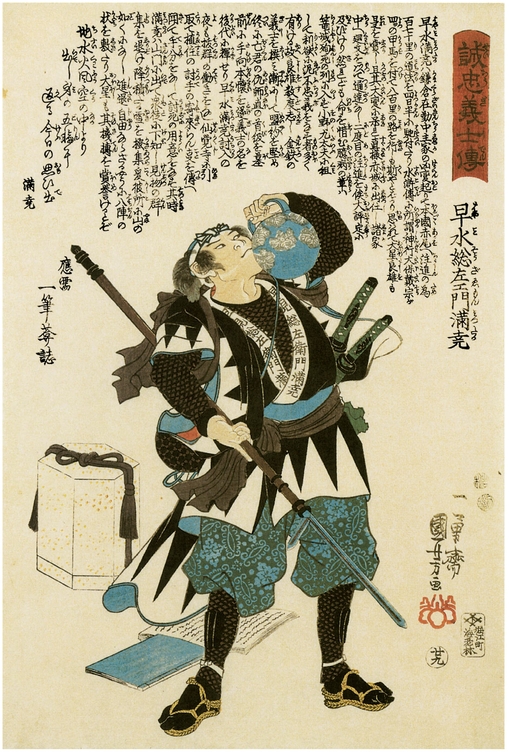
79. Hayami S zaemon Mitsutaka. Hayami Mitsutaka drinking from a kettle after the K
zaemon Mitsutaka. Hayami Mitsutaka drinking from a kettle after the K no battle was over. The six-sided box behind him no doubt contains the prize the 47 r
no battle was over. The six-sided box behind him no doubt contains the prize the 47 r nin came there for, the severed head of the enemy Moronao.
nin came there for, the severed head of the enemy Moronao.
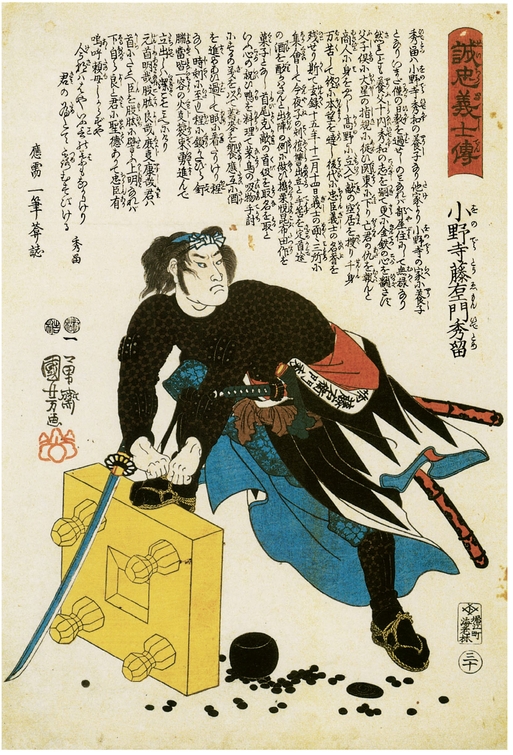
80. Onodera T emon Hidetome. The great warrior Hidetome adjusting his sandal on the edge of a tipped-over go board with the black pieces strewn on the floor.
emon Hidetome. The great warrior Hidetome adjusting his sandal on the edge of a tipped-over go board with the black pieces strewn on the floor.
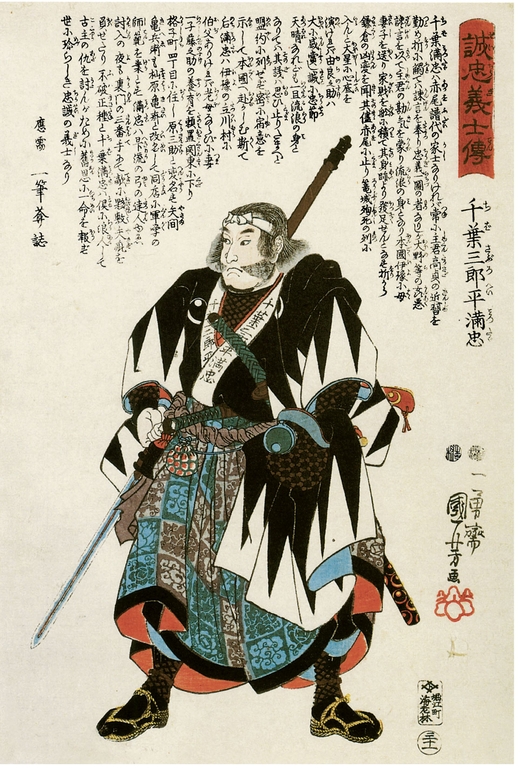
81. Chiba Sabur hei Mitsutada. A portrait of a samurai ready for battle.
hei Mitsutada. A portrait of a samurai ready for battle.
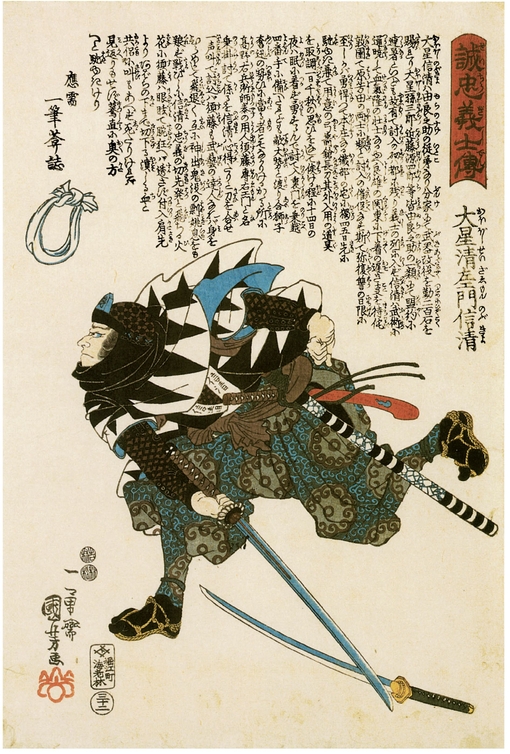
82.  boshi Seizaemon Nobukiyo. Nobukiyo was a martial arts expert who has here delivered such a devastating blow to an unseen opponent that his victim’s sword is shown flying off in one direction and his headband in another.
boshi Seizaemon Nobukiyo. Nobukiyo was a martial arts expert who has here delivered such a devastating blow to an unseen opponent that his victim’s sword is shown flying off in one direction and his headband in another.
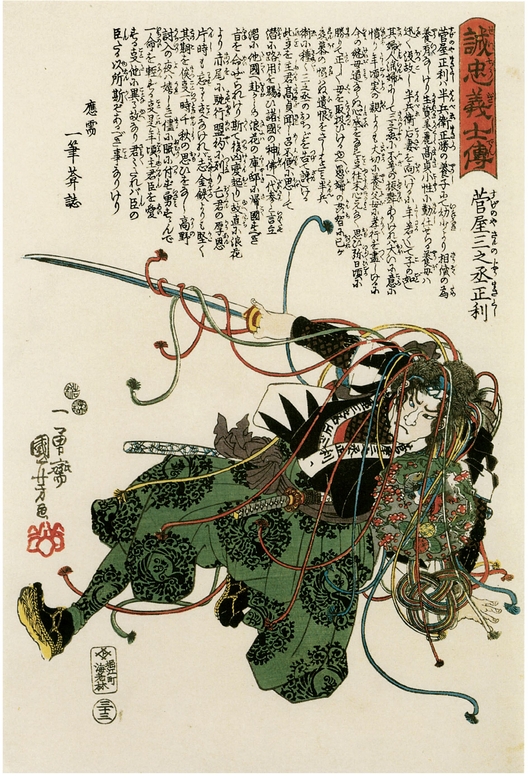
83. Sugenoya Sannoj Masatoshi. In another amusing domestic contretemps during the K
Masatoshi. In another amusing domestic contretemps during the K no attack, Sannoj
no attack, Sannoj is shown getting the worst of it from the streamers of a kusudama, a scented ball used in clothes closets and other private rooms.
is shown getting the worst of it from the streamers of a kusudama, a scented ball used in clothes closets and other private rooms.
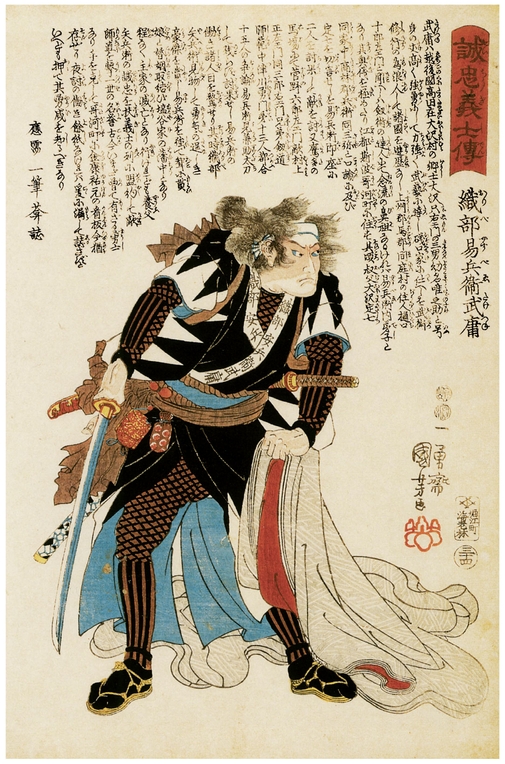
84. Oribe Yasubei Taketsune. Yasubei, a ferocious and accomplished warrior, holds the sleeping robe of the defeated enemy Moronao after the K no attack.
no attack.
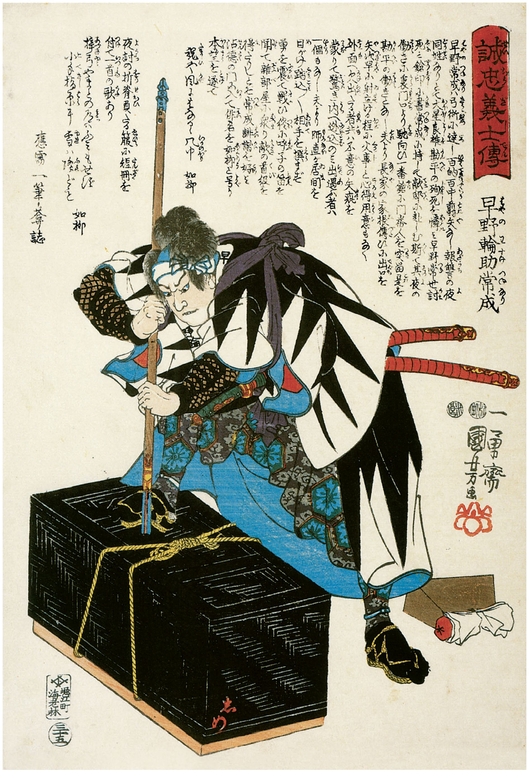
85. Hayano Wasuke Tsunenari. The samurai is probing a sealed chest with his spear, possibly searching for the enemy in hiding, Moronao. Tsunenari was present at the climax of the night attack when Moronao was beheaded.
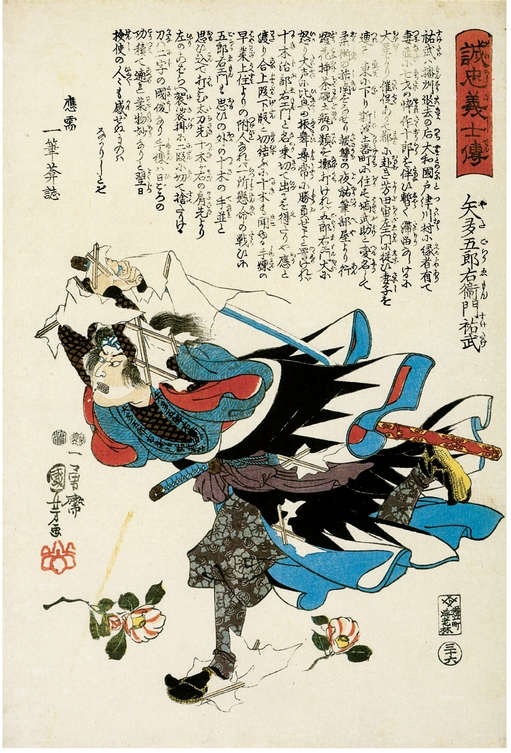
86. Yata Gor emon Suketake. Another reminder that the K
emon Suketake. Another reminder that the K no attack was an assault on a residence, Suketake is depicted fighting his way deeper into Moronao’s mansion, scattering flowers in the process and here dismantling a shoji, a sliding panel of translucent paper used as a door or window.
no attack was an assault on a residence, Suketake is depicted fighting his way deeper into Moronao’s mansion, scattering flowers in the process and here dismantling a shoji, a sliding panel of translucent paper used as a door or window.
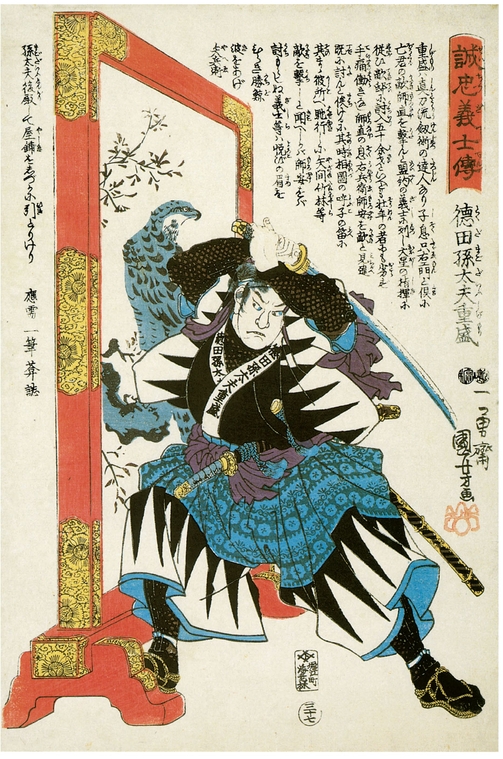
87. Tokuda Magoday Shigemori. Poised with upraised sword behind a painted screen, Shigemori is ready for action. The text related that though he was 50 years old at the time of the K
Shigemori. Poised with upraised sword behind a painted screen, Shigemori is ready for action. The text related that though he was 50 years old at the time of the K no attack, he was still as effective a warrior as his younger comrades.
no attack, he was still as effective a warrior as his younger comrades.
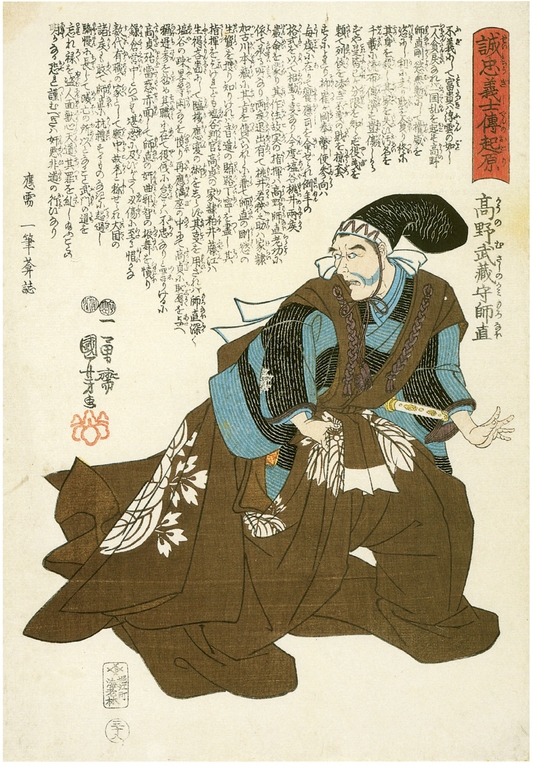
88. K no Musashi no Kami Moronao. The target of the K
no Musashi no Kami Moronao. The target of the K no attack, Moronao, wearing ceremonial dress appropriate for formal occasions, is shown cowering in fear at the time of the attack on his mansion by the 47 r
no attack, Moronao, wearing ceremonial dress appropriate for formal occasions, is shown cowering in fear at the time of the attack on his mansion by the 47 r nin.
nin.
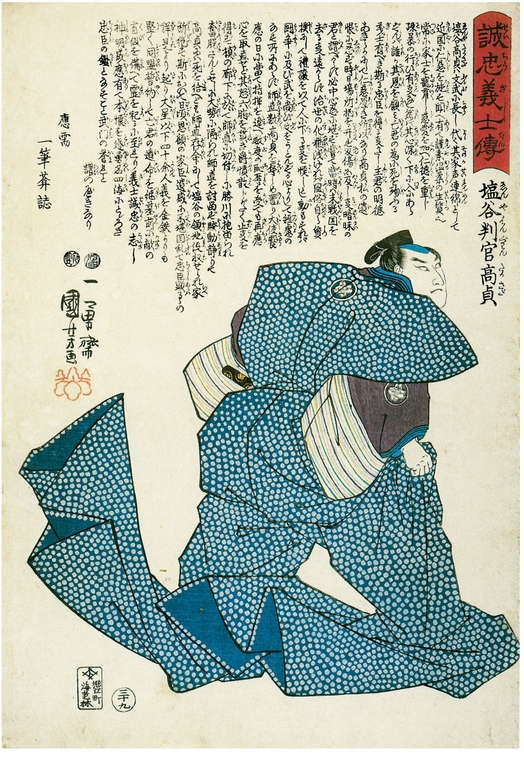
89. En’ya Hangan Takasada. Lord Asano, in ceremonial dress. His outburst against Moronao, followed by his forced suicide and the devastation of his clan, prompted his devoted retainers, the 47 r nin, to organize to take revenge on their enemy Moronao.
nin, to organize to take revenge on their enemy Moronao.
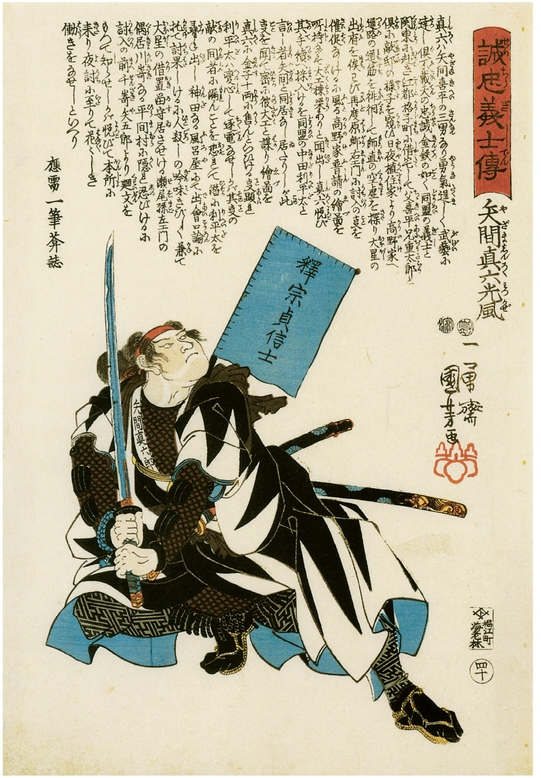
90. Yazama Shinroku Mitsukaze. A brilliant soldier, Shinroku wears a flag in battle bearing his “death name,” the name he wished to be remembered by.
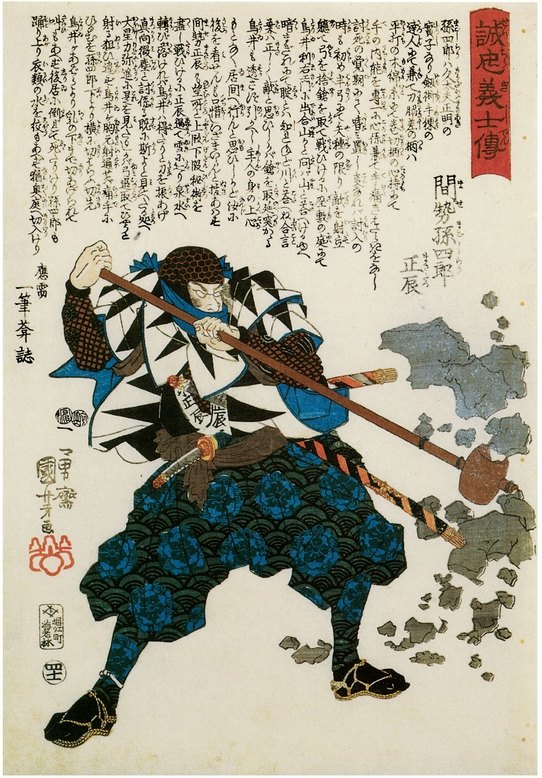
91. Mase Magoshir Masatatsu. Masatatsu smashing an earthen vessel with a long mallet. The text relates that Masatatsu’s hands were too sore from blisters for him to use his sword in the K
Masatatsu. Masatatsu smashing an earthen vessel with a long mallet. The text relates that Masatatsu’s hands were too sore from blisters for him to use his sword in the K no attack, so instead he did a lot of damage with his spear. The circumstances of the mallet attack on the vessel were not explained.
no attack, so instead he did a lot of damage with his spear. The circumstances of the mallet attack on the vessel were not explained.
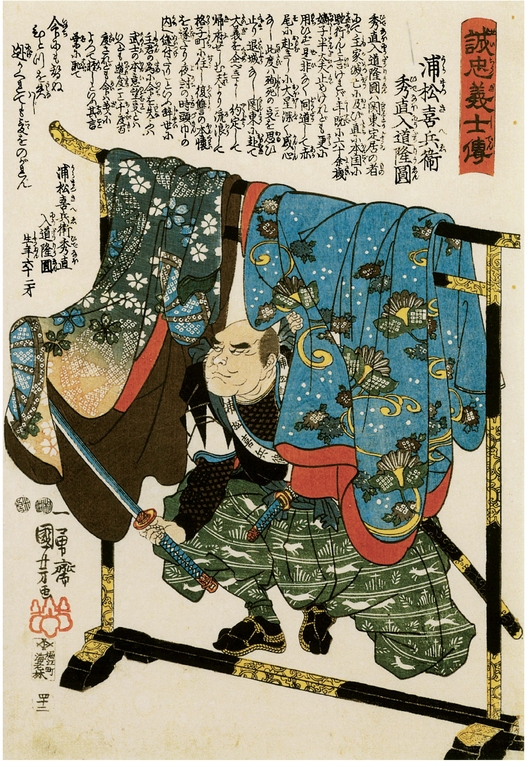
92. Ry en, Uramatsu Kihei Hidenao. Ry
en, Uramatsu Kihei Hidenao. Ry en was a lay priest as well as a samurai. Here he takes cover, sword at the ready, behind a rack of elegant kimonos, a scene no doubt intended to be gently humorous.
en was a lay priest as well as a samurai. Here he takes cover, sword at the ready, behind a rack of elegant kimonos, a scene no doubt intended to be gently humorous.
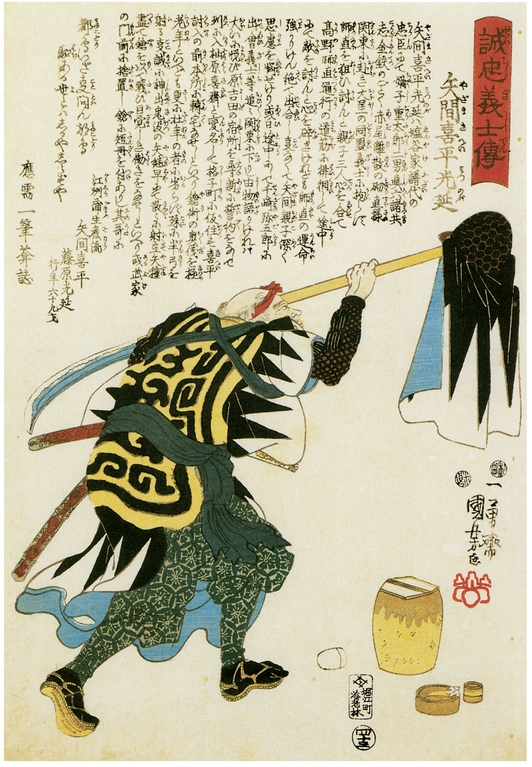
93. Yazama Kihei Mitsunobu. The samurai is carrying his helmet and cape on the blunt end of his spear.
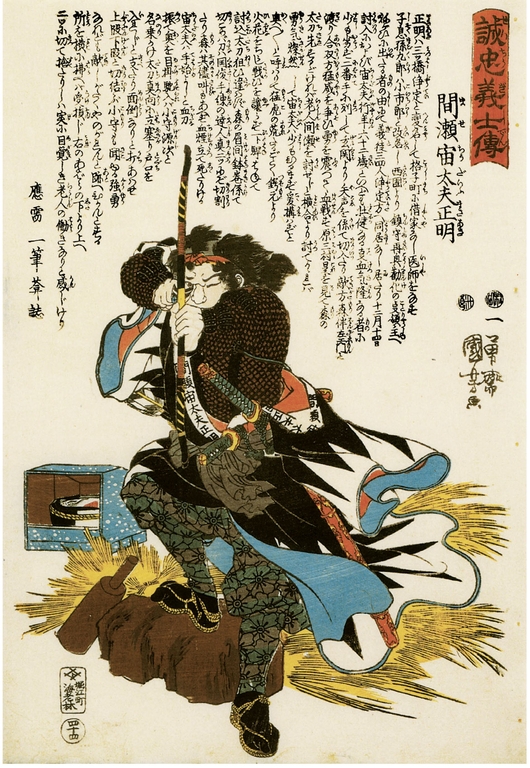
94. Mase Ch day
day Masa-aki. Mase was over sixty at the time of the K
Masa-aki. Mase was over sixty at the time of the K no attack but still a formidable warrior and expert with the bow. In this trompe l’oeil print, the arrow points directly at the viewer from any angle.
no attack but still a formidable warrior and expert with the bow. In this trompe l’oeil print, the arrow points directly at the viewer from any angle.
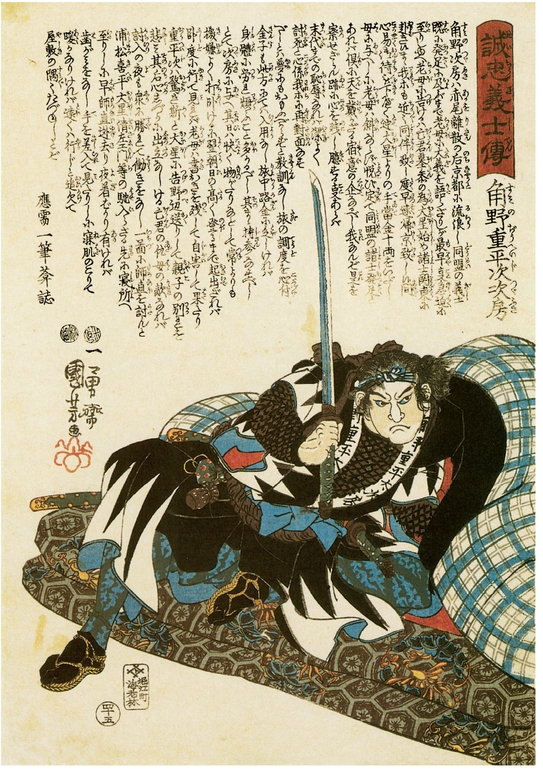
95. Sumino J heiji Tsugufusa. J
heiji Tsugufusa. J heiji feeling the empty bed of the enemy Moronao as the K
heiji feeling the empty bed of the enemy Moronao as the K no attack was nearing its end. Finding the bed still warm, the samurai knew that Moronao must be in hiding nearby.
no attack was nearing its end. Finding the bed still warm, the samurai knew that Moronao must be in hiding nearby.
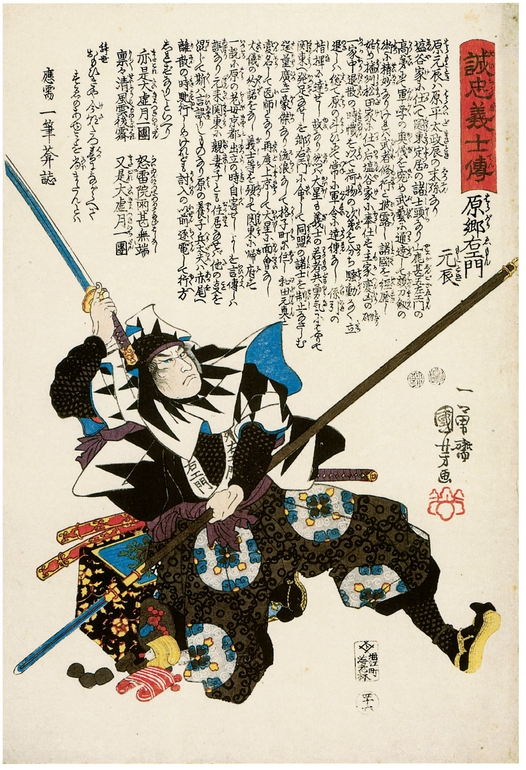
96. Hara G emon Mototoki. The samurai is seen here with upraised sword in one hand and spear in the other. There was no armor for the samurai’s feet, however; they were typically protected only by the straw sandals depicted here.
emon Mototoki. The samurai is seen here with upraised sword in one hand and spear in the other. There was no armor for the samurai’s feet, however; they were typically protected only by the straw sandals depicted here.
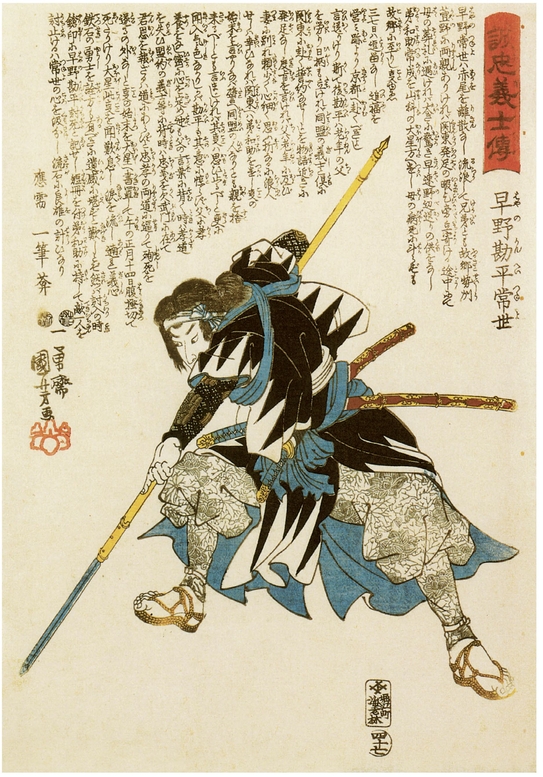
97. Hayano Kampei Tsuneyo. Kampei is portrayed as a ghost-like figure with pale skin tones and muted clothing. He missed the K no battle because he committed suicide before it took place, torn by an unresolvable conflict between his desire to fight with his r
no battle because he committed suicide before it took place, torn by an unresolvable conflict between his desire to fight with his r nin comrades on the one hand and his need to obey his aged father’s command to remain at home and care for him on the other. Suicide was the only honorable way out. In the battle the r
nin comrades on the one hand and his need to obey his aged father’s command to remain at home and care for him on the other. Suicide was the only honorable way out. In the battle the r nin leader Oboshi ordered Kampei’s brother to carry a spear with his brother’s name, “Hayano Kampei, killed in battle.”
nin leader Oboshi ordered Kampei’s brother to carry a spear with his brother’s name, “Hayano Kampei, killed in battle.”
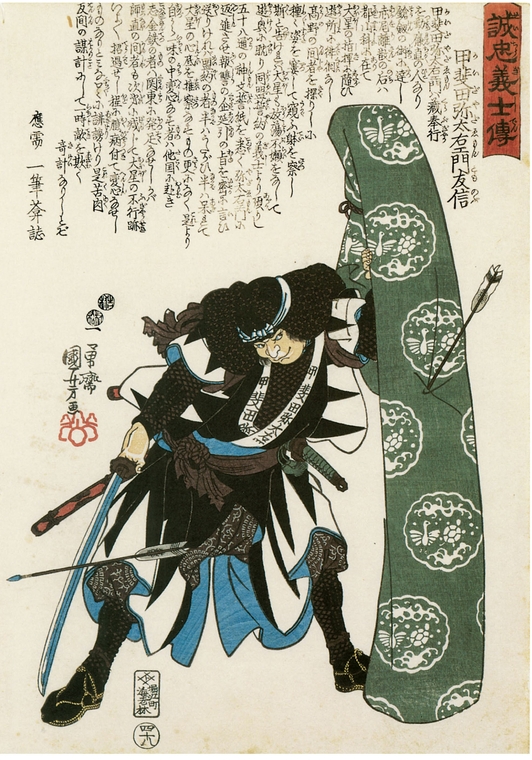
98. Kaida Yadaemon Tomonobu. The samurai defends himself from enemy arrows behind a covered koto, a stringed musical instrument.
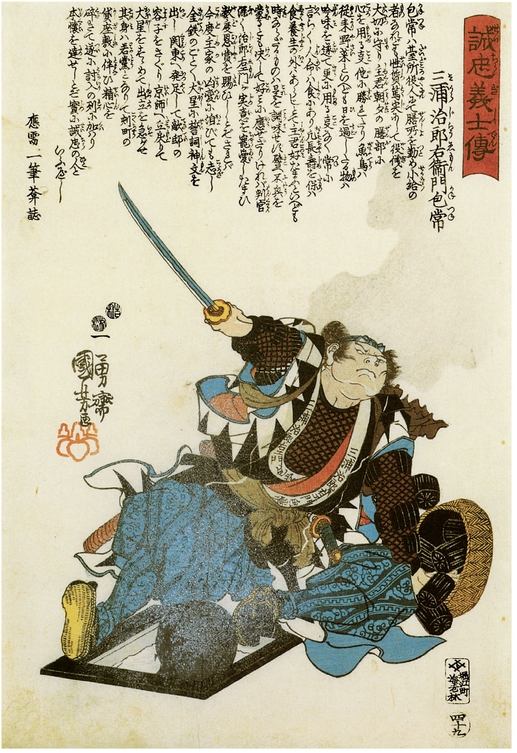
99. Miura Jir emon Kanetsune. Kanetsune was a low-ranking samurai who basically served his lord as a chef. He took part in the K
emon Kanetsune. Kanetsune was a low-ranking samurai who basically served his lord as a chef. He took part in the K no attack and is portrayed somewhat comically here, having fallen into a hearth, sword in hand, and overturned a basket of charcoal. Metallic powder was applied to the print to simulate the coal dust stirred up by this action.
no attack and is portrayed somewhat comically here, having fallen into a hearth, sword in hand, and overturned a basket of charcoal. Metallic powder was applied to the print to simulate the coal dust stirred up by this action.
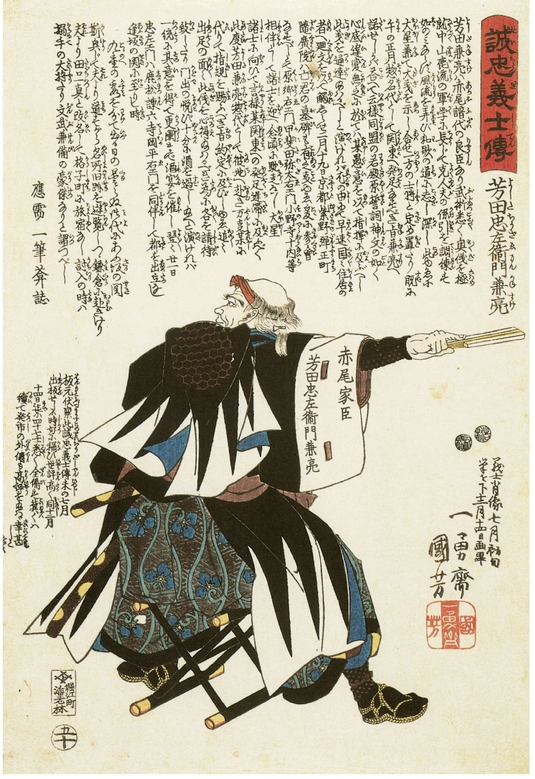
100. Yoshida Ch zaemon Kanesuke. Yoshida was, like many other samurai, an accomplished poet. Here he is pointing with a jin-sen, a battle fan used by warriors in Kabuki theatre. The banner on his sleeve identifies him as one of the faithful r
zaemon Kanesuke. Yoshida was, like many other samurai, an accomplished poet. Here he is pointing with a jin-sen, a battle fan used by warriors in Kabuki theatre. The banner on his sleeve identifies him as one of the faithful r nin, a retainer of Lord Asano.
nin, a retainer of Lord Asano.
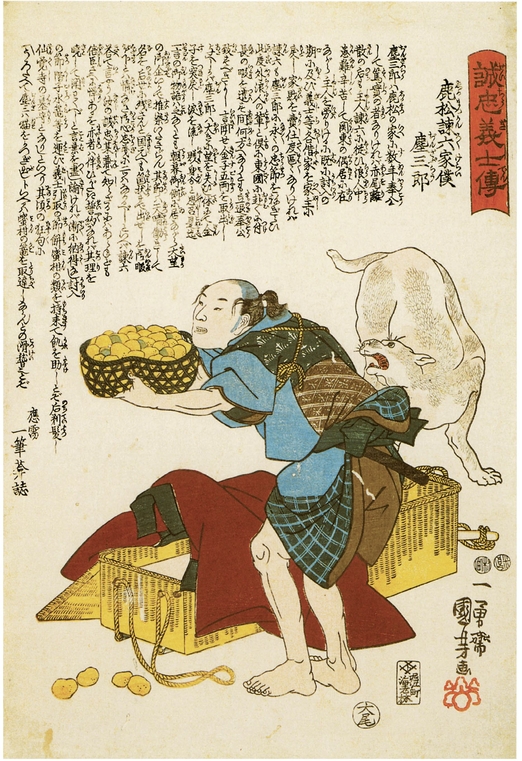
101. Jinzabur , retainer of Shikamatsu Kanroku. The last print in the series portrays Jinzabur
, retainer of Shikamatsu Kanroku. The last print in the series portrays Jinzabur , a servant of one of the r
, a servant of one of the r nin, standing in front of his huge box of provisions, holding a basket of tangerines.
nin, standing in front of his huge box of provisions, holding a basket of tangerines.